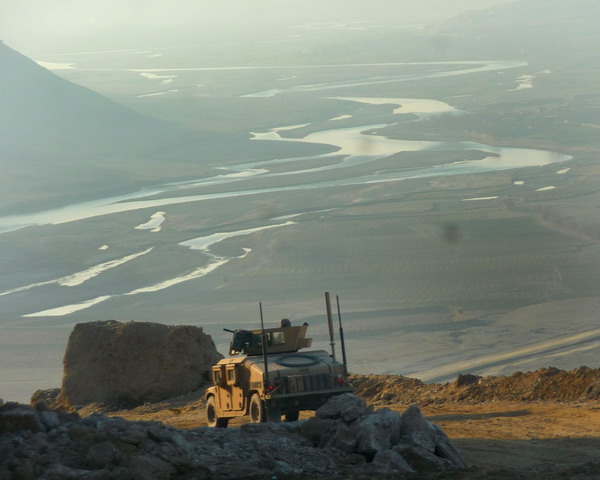
This vista is the Panjshir River in Kapisa.
Our vehicles traveling on a road we’re building.
Here is that same contractor again. He’s Pashtun and VERY jovial.
We stopped for a very quick meeting to say hello, but he insisted we have a bite to eat. He pays his 1000+ employees about $4/day (a very reasonable Afghan wage), but the big benefits are two meals a day and transportation to the mosque for prayers. Have I mentioned that Afghan food is tasty? Well, this image shows one of my favorite meals: dry bread with rice, dipped in a meat sauce.
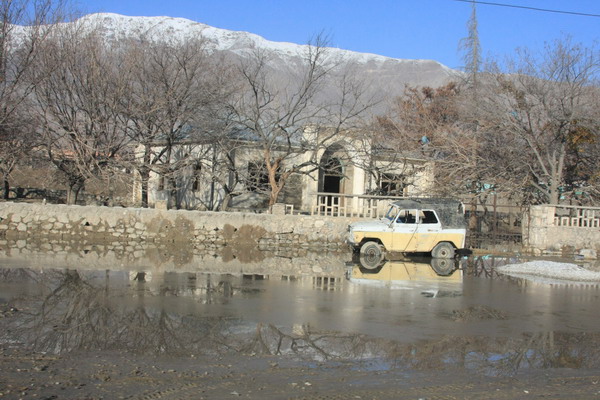
Here is another view of Parwan Province.
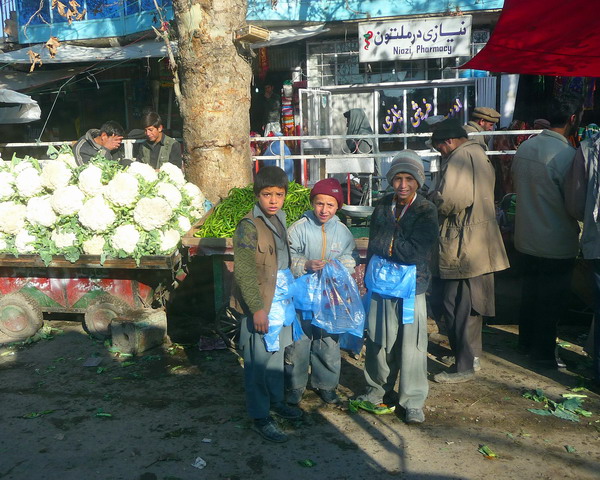
These boys are in a market in the city of Charikar.
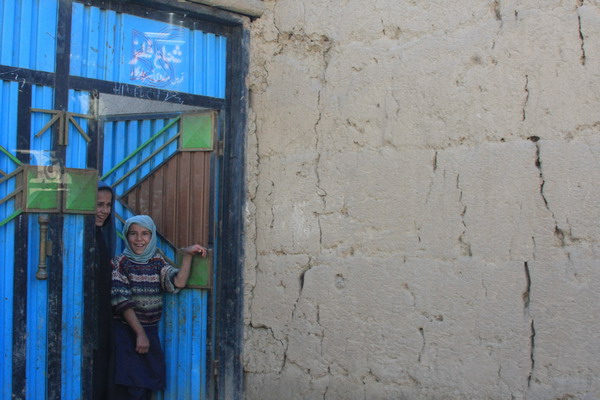
The contrast is stark here.
The next set of pictures is from our Christmas Eve party (and we repeated the event on New Year’s Eve). Jon (our Doc) wanted to share his family’s tradition with our team. So, we all enjoyed a cigar together on a cool Christmas Eve.
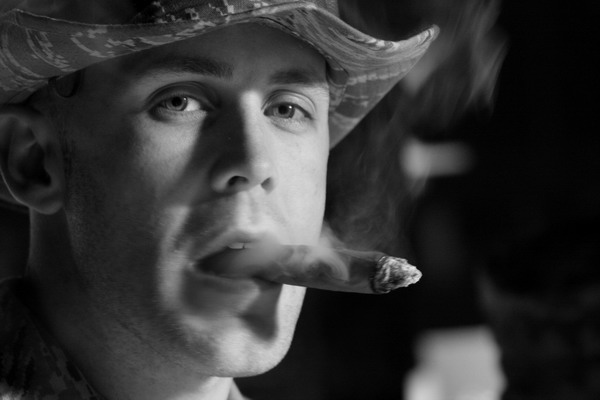
This is Patrick.

The George.

Cindy.
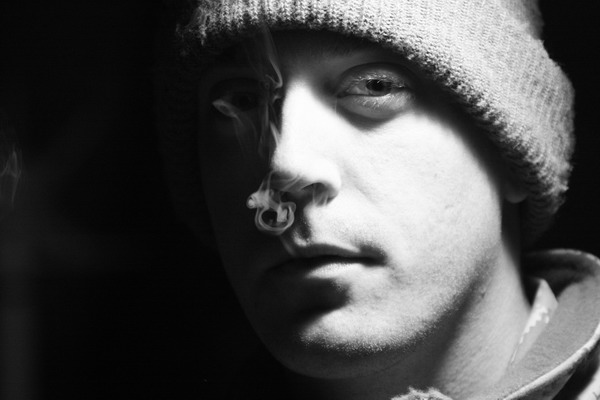
Daniel, who is gifted with languages and computers.
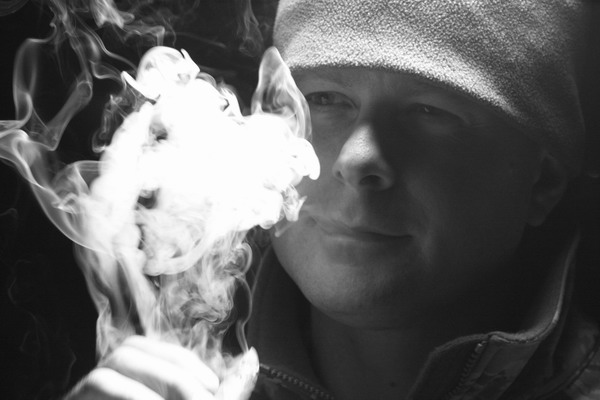
Todd, one of the other civil engineers, who does a great job, no matter what he’s doing.
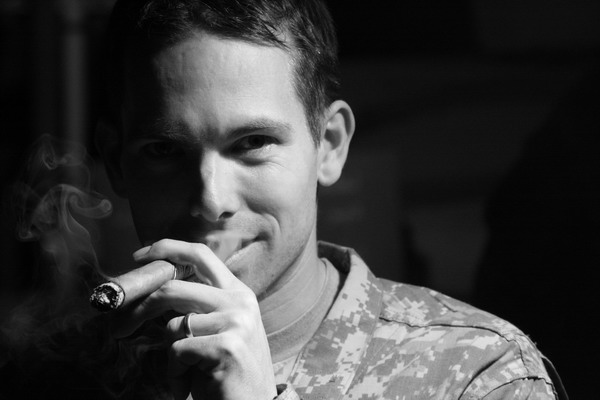
Yes, I enjoyed a cigar too (sorry, Mom).
We have many meetings with the Afghans.
The Afghans also have many meetings with us. This particular one is to gain support from the leaders of the area around a proposed project. The idea is that we present project proposals that are technically viable and sufficiently planned to a board of Afghans. They then have a voice in the process to recommend a contractor. With that process, we gain buy-in and they can help ensure a quality project is produced. Although we (the US govt) retain final authority to choose a contractor, the Afghans help us choose the best contractor for every project.
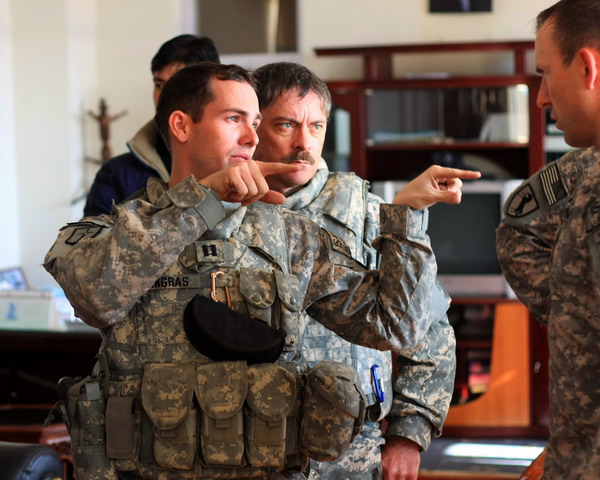
I know I look a little funny in this picture, but I was emphatically indicating where we needed to go.
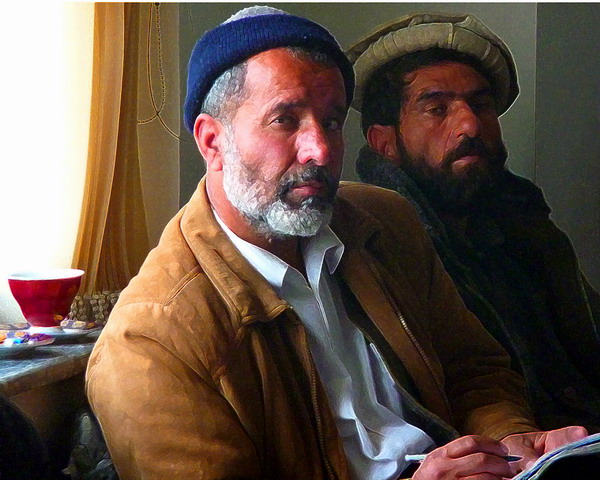
These gentlemen were in a meeting with us. I love the lighting in this image and the Chief added a great filter. Now, I think this image could be from an Afghan Van Gogh.
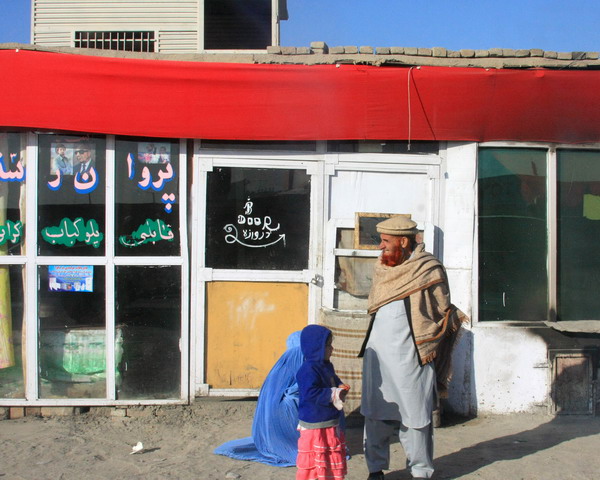
I’m not sure if this color is natural or not, but it’s certainly colorful.
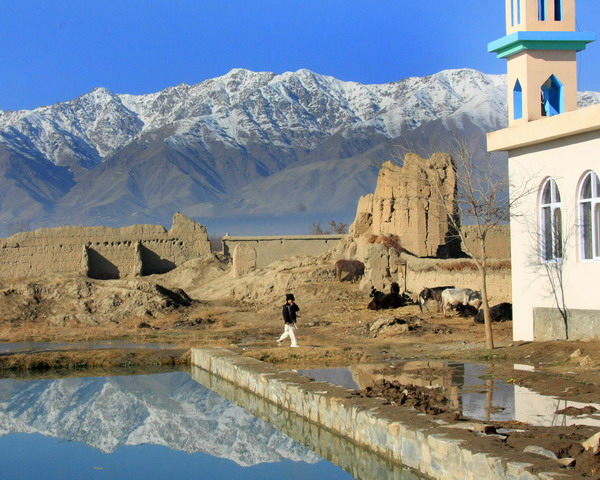
More interesting contrasts: the new and old, the water and desert and reflection and reality.
Those images depict our second month here. My time here remains a very rewarding and exciting experience.
I look forward to the summer when construction can resume in earnest.
Until the next post…
–Jim
Category: Commentary
Afghanistan — Month One
Well, I have now been in Afghanistan for a month and a half … and this country is as beautiful, amazing and more troubled than I remembered. However, I feel that although we have a long way to go, progress is being made. As you may recall from my post in October, my role here is the lead engineer on a provincial reconstruction team for Kapisa and Parwan provinces. My team is made up of military from the Air Force and Army, as well as civilians from the Departments of State, and Agriculture, and the US Agency for International Development. Our role is clear: help the Afghan people by helping to improve Afghan government, infrastructure and rule of law all to enable economic development and prosperity. At the same time, Afghan and coalition forces provide the requisite security.
I truly believe once people believe that their government is legitimate and enduring, trust their court system, have the ability to earn a licit salary Afghans will end this conflict themselves. I work everyday with Afghans and their enduring hope for the future gives me reason to work as hard as possible to help them realize their dream of a safe, stable, and successful homeland.
This is truly a worthy cause that the international community needs to see through to completion.
You can see from this picture just how ruggedly beautiful this country is.
This picture is a little out of order, but it’s from the flight in on a C-17. You can see varying levels of anticipation in everyone’s face.
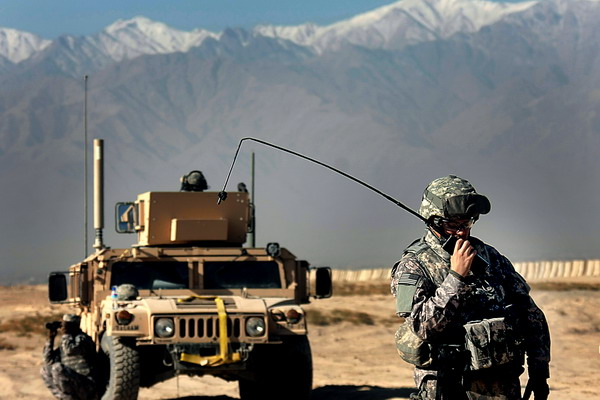
This is Lionel directing the operation. We were out making sure our weapons still worked.
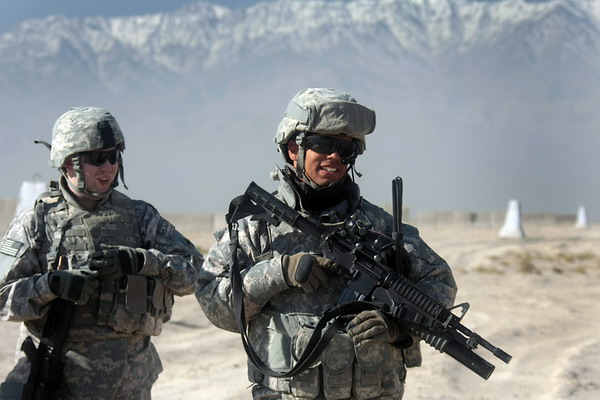
SGT Durden (on the right) always has a smile, great attitude and is a member of the hard working security force for our team.
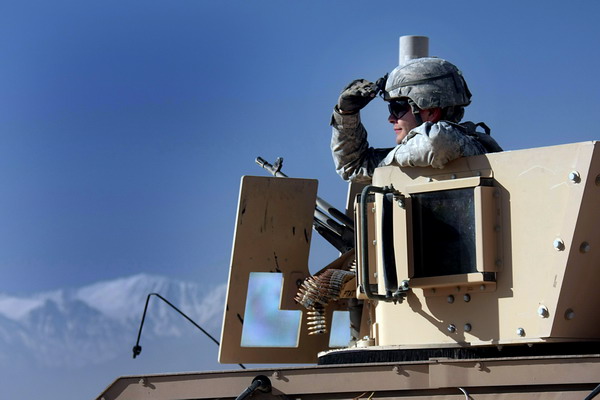
JePe (pronounced Hep Pay) checking our perimeter.
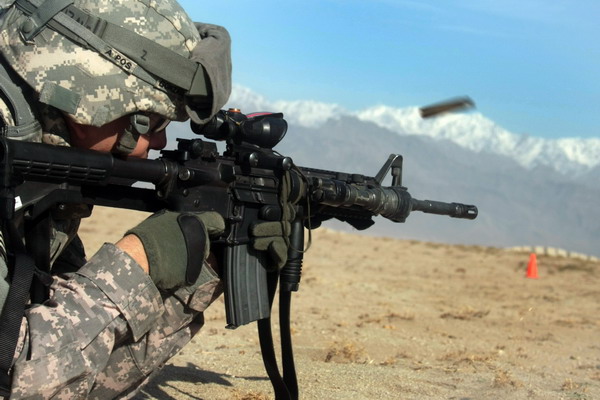
Yep, the weapons still work.
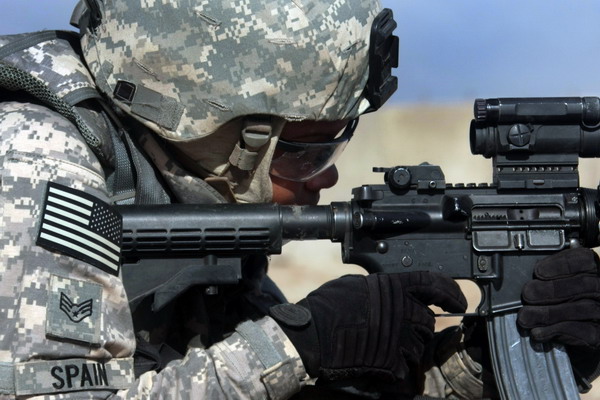
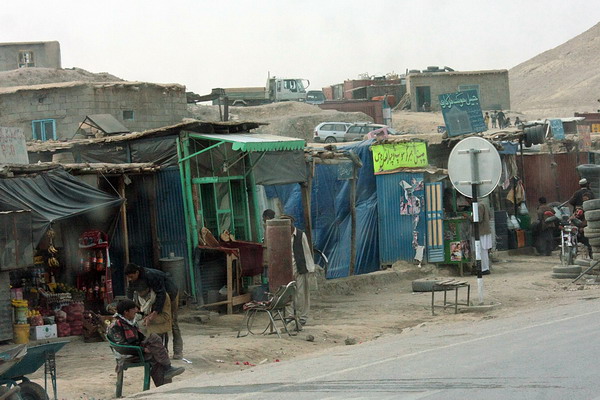
This is probably the most common form of commerce in Afghanistan. A small booth along the road. As you can imagine, the better the road, the better the access to markets. As such, we’re very focused on building and improving roads.
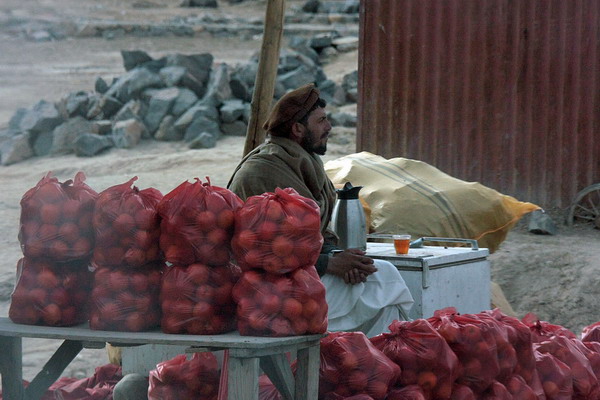
This vendor is selling my favorite Afghan produce, pomegranates. These tasty treats were first cultivated in this area and are grown extensively in the area. One of our projects was to help connect farmers in our area to local markets. Economist Article on Pomegranates This fruit has the potential to be a cash crop and replace poppy production in some parts of the country. We’re also working on two saffron development projects with a similar goal.
Many remnants of the Soviet War still remain.
You can see why passable roads are important.
These guys are the ones who ensure we’re safe as we go around the countryside.
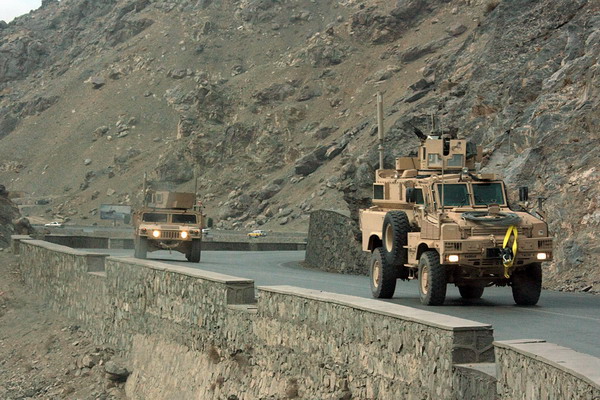
I’m sure you recognize the up-armored HMMWV on the left, but the vehicle on the right is an MRAP and provides even more protection.
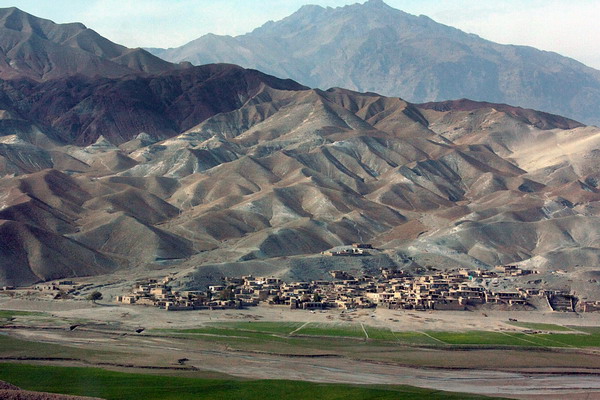
A typical Afghan village.
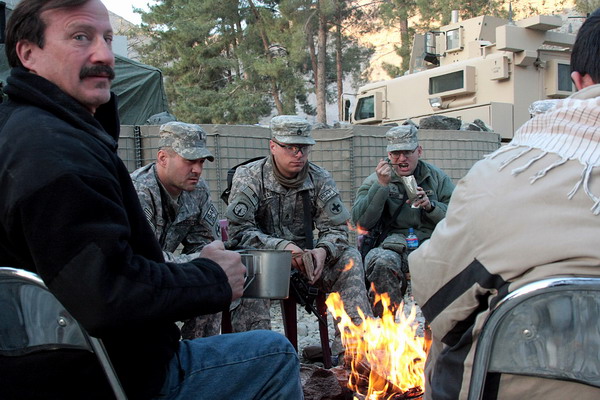
This is an image from one of the austere FOBs we stayed at. Although it was small, the campfire was a nice touch.
The guys had fun sitting around telling stories. The Afghan National Army also has some soldiers here. So, I enjoyed having a traditional meal with their commander. He has some very interesting ideas on how to solve the problems of his country. As you might imagine, he believes that security is the number one problem (I didn’t disagree). However, to fix it, he recommended, “instead of sending another 20,000 American troops, use that same money and train 100,000 more Afghan soldiers. We know our country and with enough people, we can get it done right. I am willing to die for my country. I don’t want you to have to.” Although the solution isn’t viable, it was a very interesting conversation. Keep in mind, this whole exchange was done through an interpreter. Although I am learning Dari (Afghan Persian … the language of many people in Afghanistan), I am not even close to fluent. So, without the help of these unsung heroes, we couldn’t hope to succeed.
This is Naghlu Dam and provides a great deal of power to Kabul. Unfortunately, it doesn’t power any of the surrounding region, a region that is particularly unstable. Someone at the Embassy told me, “this war can’t be won in Kabul, but it can be lost in the provinces.” Perhaps we can renovate this hyrdo-electric power source and use part of the power to electrify the surrounding valleys.
Although the electricity would be great for this area, water is its lifeblood. So, the proper management of that resource is paramount.
It is a very pretty lake. The water and arid area make a stark contrast.
This is one of our projects, building a road where there was none before. Although there is heavy equipment working on the road, we like to see a large local workforce on the project. It means they have a greater sense of ownership and provides a job for a large number of people.
You can see one of the village elders points in the direction of his house.
We always attract a lot of attention. Our security force provides a vigilant overwatch.
A pretty sunset over Naghlu lake.
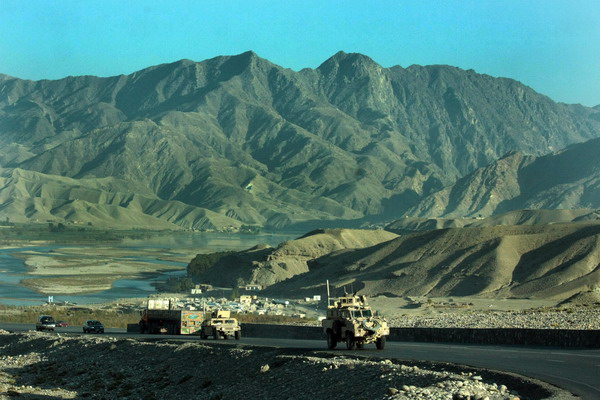
Our convoy.
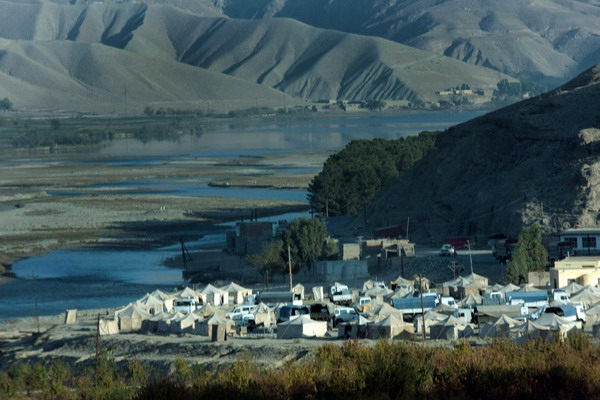
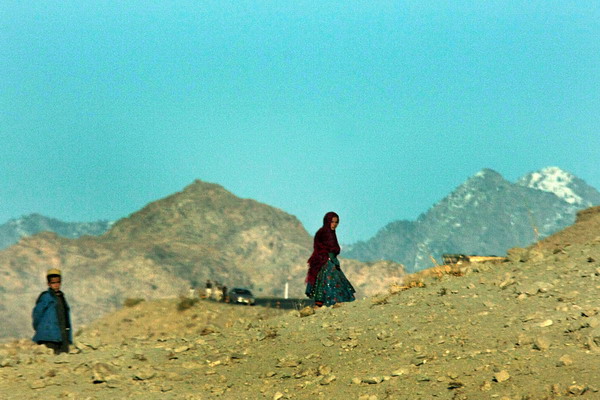
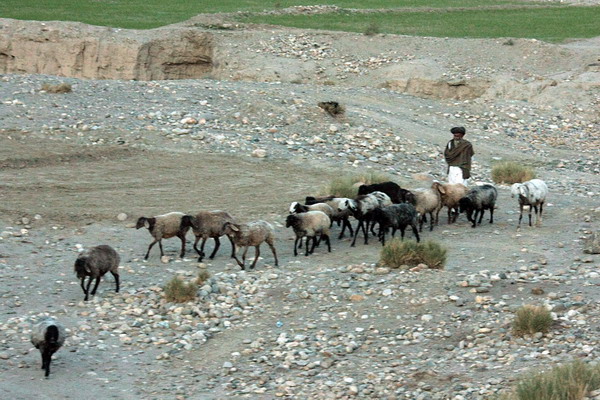
We love this billboard because it says so much, so well.
I love this picture of a young Afghan.
There are many more pictures that I will include in the next post. Also, these images are from several people on the team and the Chief was kind enough to help me clean up the images.
In case you can’t tell, I really enjoy being here. Although I wish I could spend the holidays with Anna and the rest of my friends and family, I feel this is a good place to be. My team and I are doing our best to help the Afghans and that is a good reason to be away from everyone.
So, until the next post…
–Jim
Army Training, Sir!
OK, for those who have not heard, for all intents and purposes, I am in the Army for the next year or so. I have been training with the Army for a little more than 2 and 1/2 months now in Indiana, as well as North Carolina in preparation for a deployment to Afghanistan this fall. We began with language and cultural training at Indiana University, then moved to Fort Bragg in North Carolina for combat skills and mission specific training.
My team is one of the provincial reconstruction teams. Our mission is to help the Afghan government rebuild their country, economy and government. My focus on the team will be construction. I am very excited to be a part of this mission. We (and the thousands of other diligent military and aid workers) have the opportunity to affect a great deal of positive change for many people. 30 years of near constant warfare has taken an enormous toll on the entire country.
As for my time here in North Carolina, it’s been very valuable training, but certainly has included a number of ups and downs. We will continue our training for another month or so, then head to Afghanistan. As you can see, we focus on combat skills here. Our mission is to rebuild, aid and enable the Afghan government, so hopefully, we won’t have to use these skills, but we are learning them, just in case.
If you are interested in more details about our mission and training, the following links will provide more insight:
PRT Overview
‘Outside the Wire Mission’ Article –>I am actually quoted in this article.
‘Language Immersion’ Article
Deployment Preparation Article
An article about the current PRT
Another article about the current PRT
With all that background reading out of the way, allow me to present a few images from the first part of our training. Fortunately for me, our chief here is a phenomenal photographer (also happened to be one for the Air Force as well). So, these images are a combination of his and mine. He was very kind to share them with me.
As a format side-note, I will try posting my comments directly under pictures, instead of on top as they were in prior posts.
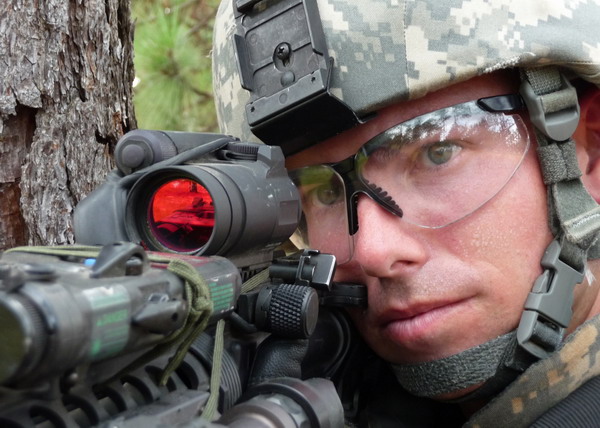
This is me looking through the sight on my M-4.
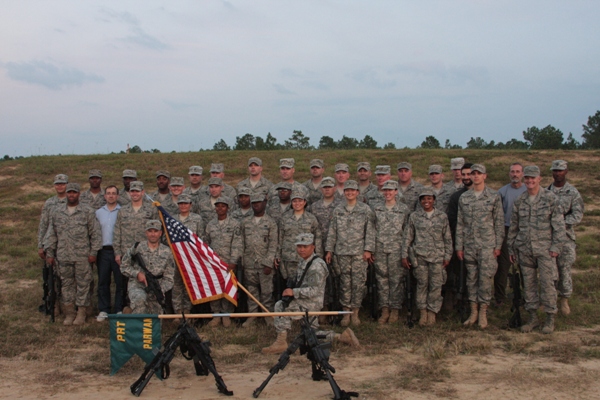
This is an image of the whole team
Now, for the title to this entry. It is homage to the continued relevance of the movie “Stripes.” For reference, it was released in 1981 and is a timeless classic. In fact, the barracks in that movie (along with just about any other released since WWII) are the exact same that we lived in when we first arrived.
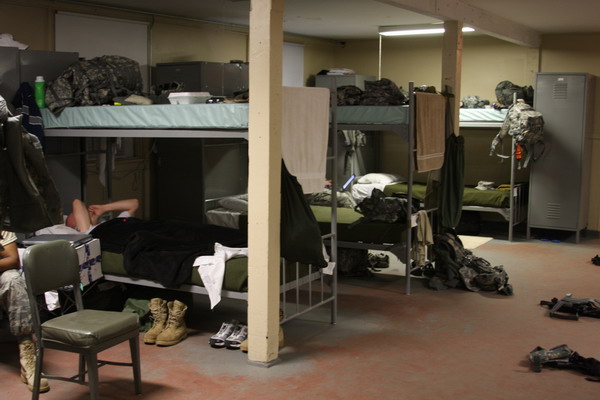
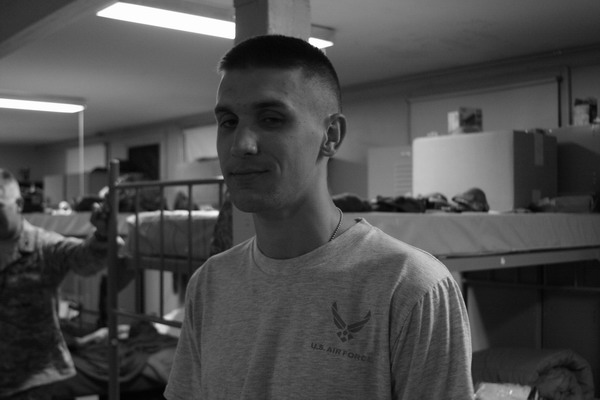
One of the other engineers, Joel, looks very happy to be there. Don’t you think?
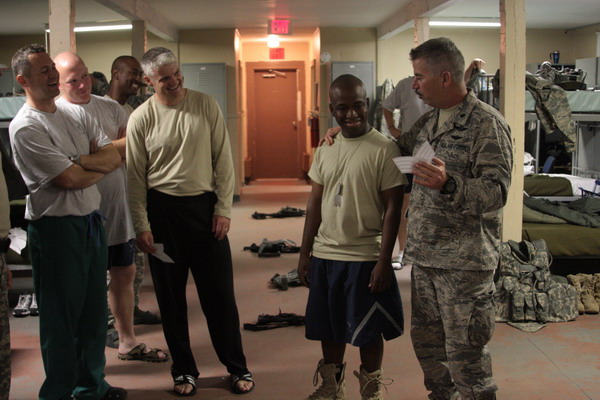
We quickly came together as a team. Here, you can see the Airman in the center was selected for promotion. The commander is congratulating him on a job well done to earn the advancement.
In the early part of our time here, we had specific training. During a session for the engineers, we got stuck in the middle of a micro-burst. It was nearly the intensity of a tornado, and experiencing that in a tent was… interesting.
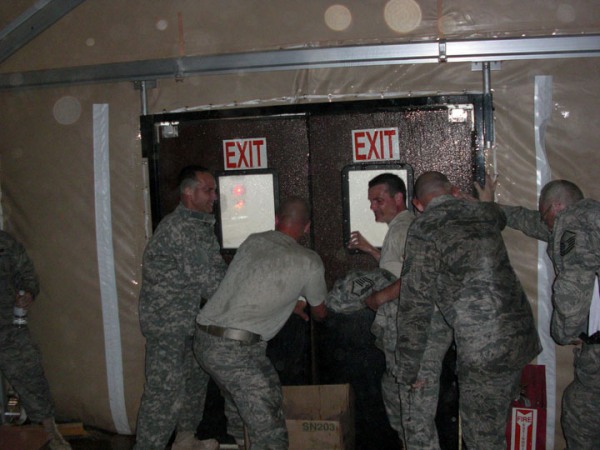
These guys are trying to hold the wall of water back. It was about 70 mile an hour wind, with rain and hail. Oh, and when we realized that holding aluminium poles with lightning all around wasn’t a good idea, we headed straight for the bus.
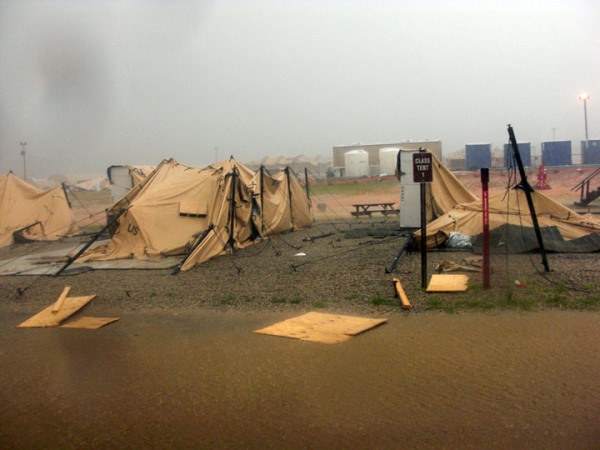
Here is some of the destruction after.
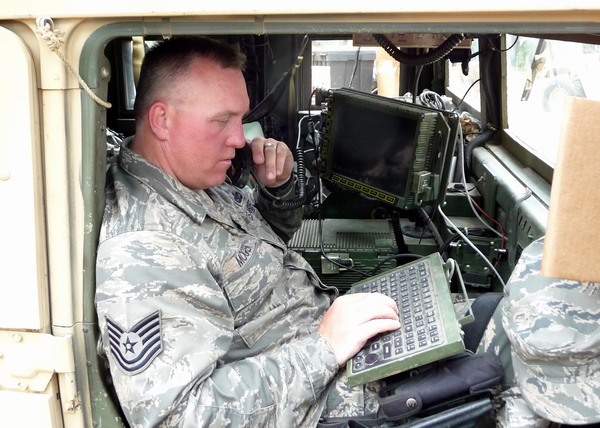
Multi-tasking in a HMMWV (AKA Humvee).
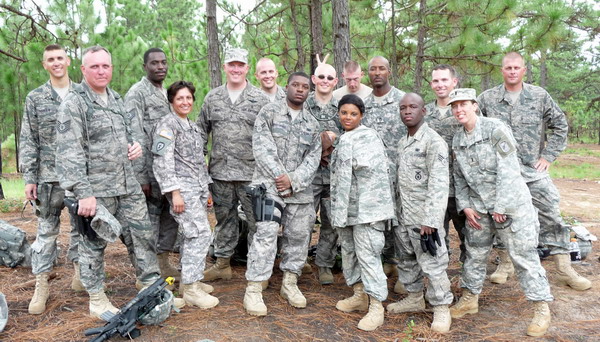
Part of the team after a long day of training.
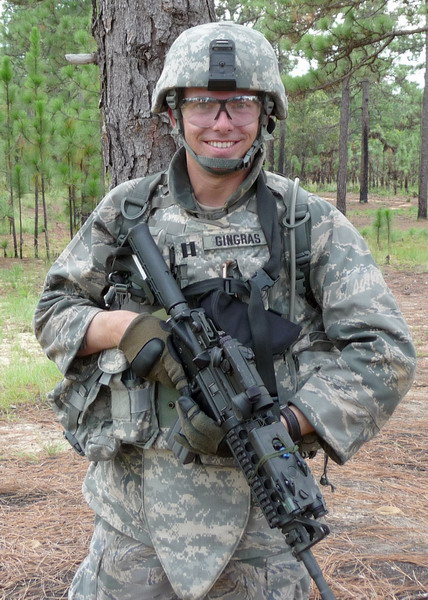
Fortunately, communication equipment normally works, even in the woods of North Carolina. It’s amazing that even in the middle of nowhere, you can stay in contact with the outside world.
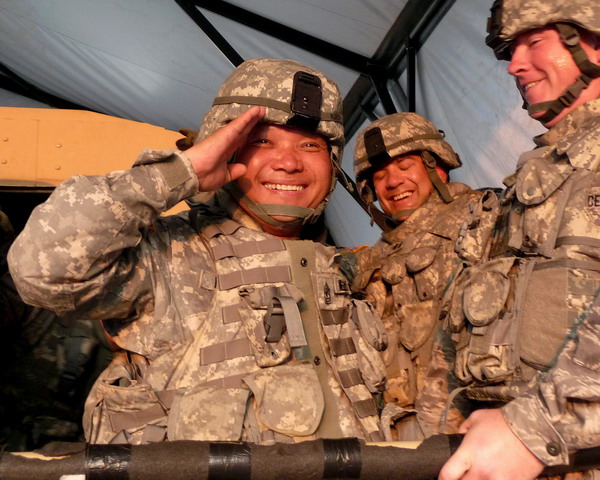
Top (the informal form of address for an Army First Sergeant) had a good time in this simulator. It taught us what to do in case of a vehicle roll-over, which is a very disorienting experience.
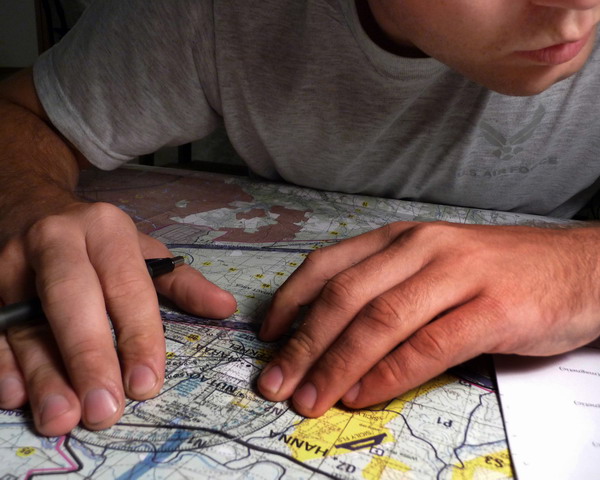
Map reading, and land navigation (both day and night) are essential skills that we reviewed and practiced.
We got a bit of hand’s on medical training. As you can see here, we began intravenous saline treatments on each other. There is much to be learned by actually doing it.
As you may be able to tell, I am less than thrilled going through this process.
MAJ Mundt, looking like the quintessential soldier.
These next two images are me working on a 50 caliber machine gun.
Everyone had to prove their ability to load, clear, disassemble, re-assemble, then function check several crew-served machine guns in a short amount of time. The only one that gave me trouble was the Mk-19, which seemed to have about 50,000 pieces. There is a picture of a Mk-19, a little later on, if you are interested.
Concentrating VERY hard.
More field training. This time with the M-4, the standard weapon we carry all the time.
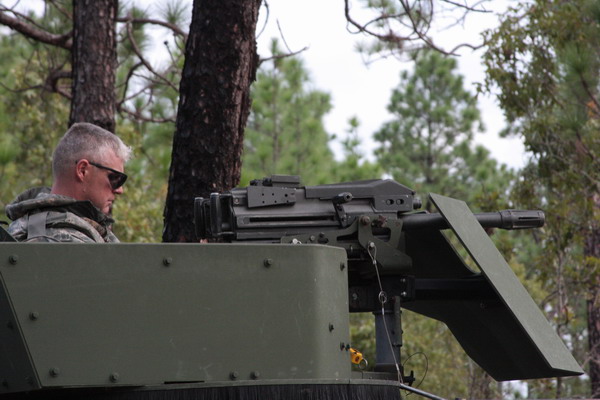
Here’s the Chief with his Mk19 on top of a HMMWV.
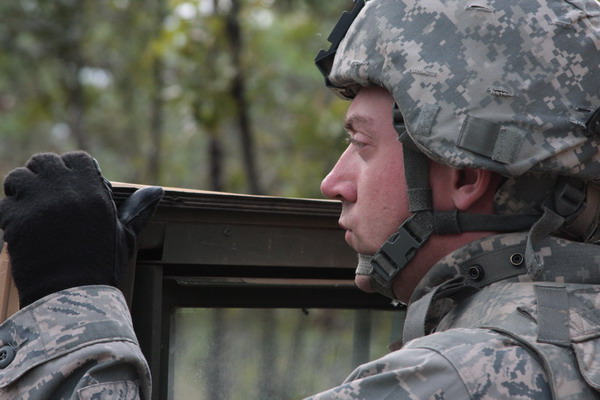
Daniel kept a sharp eye out during our base defense exercises.
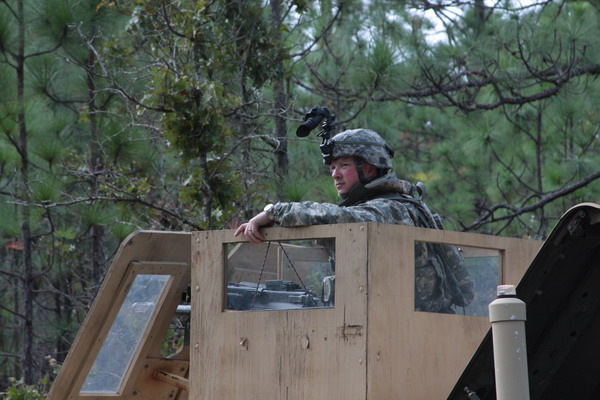
So did Matt, even at night.
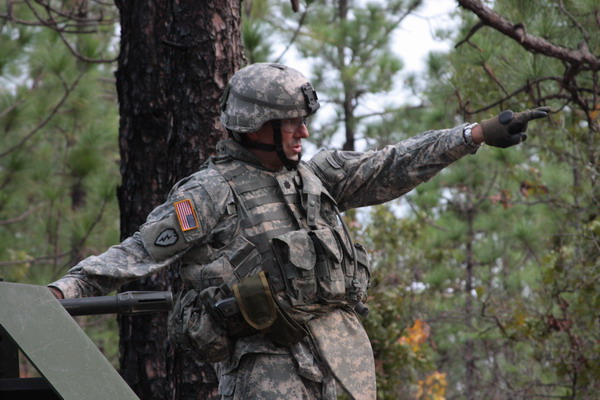
LTC Kenna giving us direction.
Sitting around, telling stories has been an essential part of our experience here at Ft Bragg. Actually, everyone that I have talked to and who have trained with the Army has said that.
For almost a week, the team was expected to sleep outside (instead of our normal tents). Oh, we spent several weeks in those WWII barracks, but then moved to a “Forward Operating Base” that consists of a number of large (12-16 person) tents. That is where we have resided for a while now… Here you can see the chief made the most of his time out in the woods and brought several creature comforts (no pun intended).
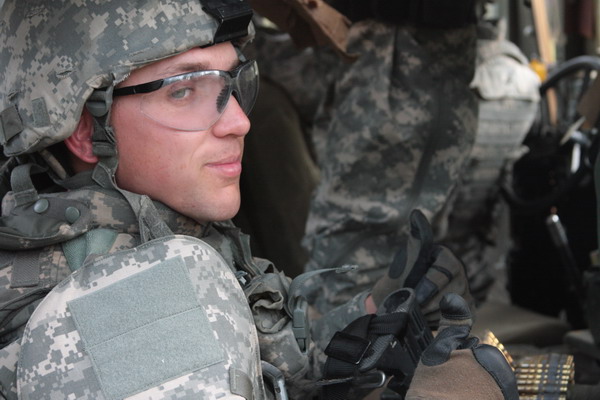
Joel was also ready to defend our base.
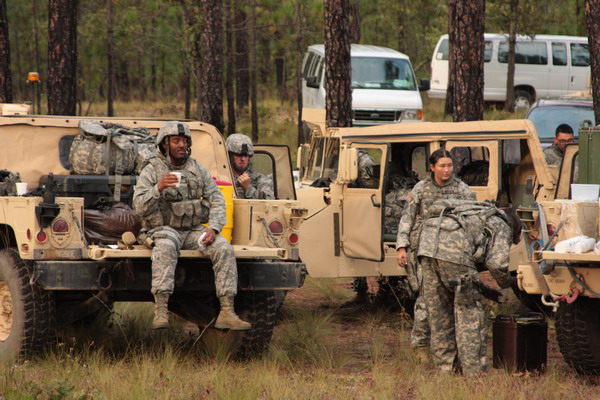
Our only place to relax for a few minutes during a lull.
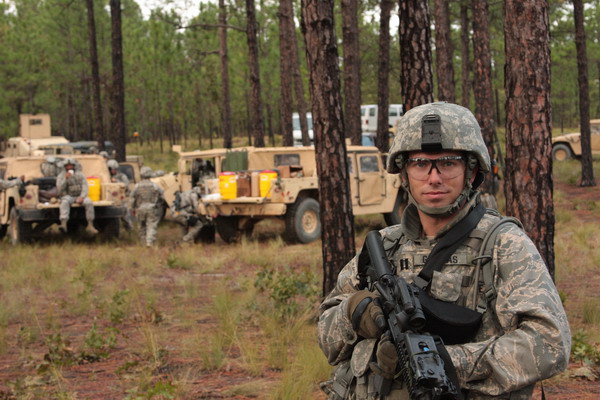
Yes, I too was ready to defend.
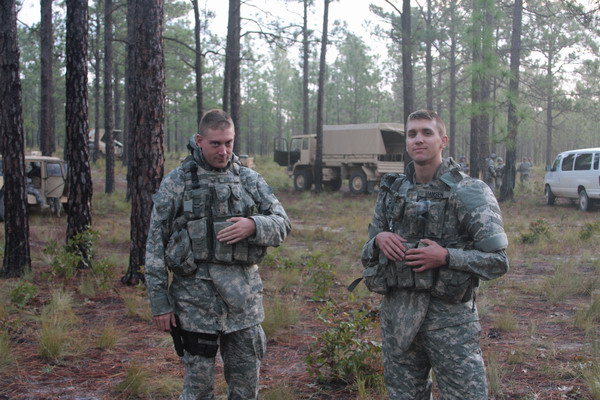
I know Daniel looks a little scary in this picture, but it was about 6 o’clock in the morning. We all look a little scary at that time of the day.
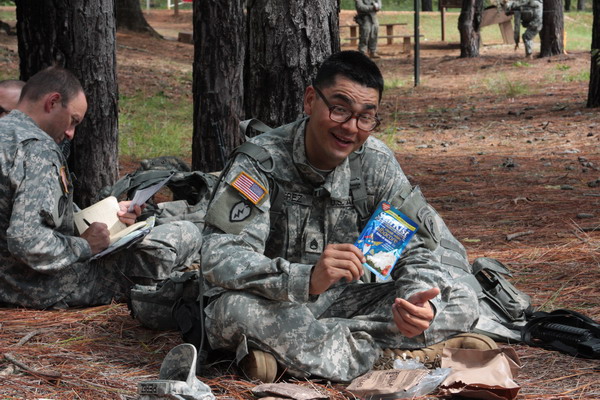
Nearly every day that we’ve been here, our lunch (and sometimes breakfast and dinner) has consisted of a Meal Ready to Eat (or MRE). These are pre-packaged food that is supposed to last for several years. In my opinion, they could probably survive in a nuclear winter. Although their quality has improved significantly over the last decade, it is no culinary masterpiece.
These next two images are from the Chief. He caught G-right and Slagle in the nice afternoon sun.
This is G-right
Slagle is enjoying his cigarette.
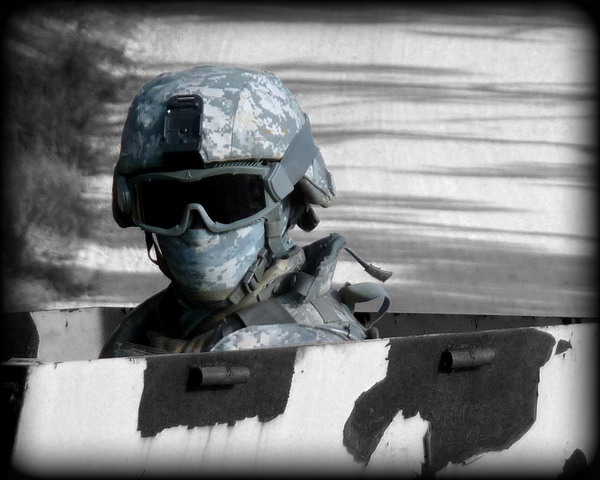
This is G-right again. This time he’s in his gunner’s turret of the Humvee. The chief did do some minor retouching to his image, as you can tell.
That concludes the training, as of right now. Next week, we have a big culmination exercise to practice all the skills we’ve learned. In the near future, we will head out to Afghanistan and use them for real.
So, until the next post…
–Jim
Battle of the Bulge or Operation Wacht Am Rhein
A couple weeks ago, a group of us had the opportunity to witness the site of one of the most seminal battles of World War II. Officially it was named the Battle of the Ardennes by the US Army and Operation Wactch am Rhein by the Germany military, but popularly known as the Battle of the Bulge.
It’s a violent tale from history that happened right in our backyard. We had the opportunity to listen to a lecture by an American and Belgian historian. They provided us with background knowledge and pictures from the pivotal time before, during and after arguably the most important battle of the European theater in WWII.
For those that aren’t well versed in 20th century military history, please allow me to provide you with a thumbnail sketch of this titanic clash.
Toward the end of 1944, the allied advance through Europe had been faster than expected and stretched the forces out over a large expanse of the continent. This presented a severe logistical problem for the Allies and coupled with the failure of Operation Market Garden (British Field Marshall Montgomery’s failed attempt to bypass the Siegfried Line and cross the Rhine), presented a very tempting target to Hitler and the German commanders. So, the German military decided to try and split the American and British forces, in the hope that Germany could force both the US and UK to seek peace independent of the USSR in the East, thus giving Germany more time to complete their extensive work on secret weapons like jet aircraft, super heavy tanks/U-Boats and of course, nuclear weapons.
This belief sparked Hitler to try another Blitzkrieg (Lightning or Flash War) maneuver to encircle four Allied Armies and retake the Belgian port of Antwerp. This would mirror what the German Army did in 1940 during the successful Battle of France. The difference this time would be instead of using the Ardennes forest to cover the advancing German army, it would be the site of the battle. The close terrain of the forest made rapid movement difficult, which was ideal to trap an army (or armies) in the dense woods.
In order to achieve success, the German High Command needed to achieve complete surprise. Also, the weather had to be poor to neutralize the deadly air superiority. The German advance had to be quick to encircle and trap the allied armies and the Allied fuel supplies had to be captured intact, since the air raids in Romania had starved the German military machine of its lifeblood.
The Allied armies also suffered from a recent lack of intelligence. All through the campaigns in France and Italy, the Allies were able to intercept and decrypt ULTRA intelligence from German radio transmissions with the help of an Enigma machine. As they crossed into German territory though, the German army didn’t rely on the radio, but land lines which weren’t as easy to decipher. The very helpful French resistance was unable to supply information about the German homeland for obvious reasons as well. Finally, a foggy autumn also hampered the Allied forces from correctly assessing the situation.
Popular belief was that the German army was in no state to wage an offensive. Also, the Ardennes was considered a quiet sector, so it was used as a training ground for new units and a rest area for those that hard seen hard action.
This was soon to change.
On December 16th, the battle began. It was a multi-pronged attack, with paratroopers, infantry and armored cavalry, along with special tactics like Otto Skorzeny’s battalion of English speaking Germans. Their goal was to take vital bridges over the Muese River. Although they failed at that, they did produce great chaos and inflicted much damage on the logistics of the Allies. Checkpoints were set up all over the rear and servicemen were grilled on all things American. For example, what was the identity of Mickey Mouse’s girlfriend, baseball scores, or the capital of Illinois. That last question resulted in the temporary detention of General Omar Bradley. Although he correctly answered Springfield, the soldier asking seemed to think the correct answer was Chicago. Apparently American geography wasn’t the best back then either!
Unfortunately, when the main armored spearhead of the Sixth SS Panzer Army met the lightly armored American 285th Field Artillery Observation Battalion, there was very little contest and the Americans surrendered to the overwhelming German force. About 150 unarmed men were herded into an open field near Malmedy, Belgium. Although no official order appears to have been given, the Germans opened fire and cut down the American troops. Then, several went through the survivors and methodically spotted those still alive. Fortunately, a few escaped to bring the tale back to the others. This story spread like wildfire and similar to the Alamo or USS Maine became a rallying cry. It also led to the common practice of not taking prisoners.
This is an image from that massacre in 1944.
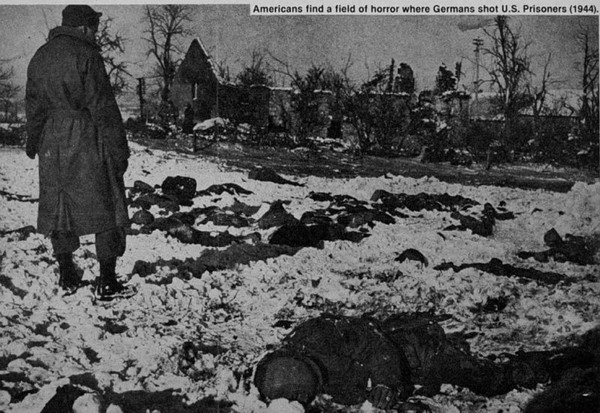
Today, outside of Malmedy, the field of the massacre is still just a field, but there is also a museum and two memorials to commemorate what happened. Here are a couple images of that memorial.
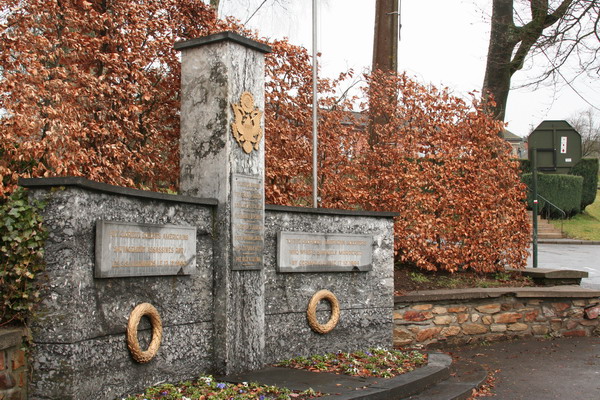
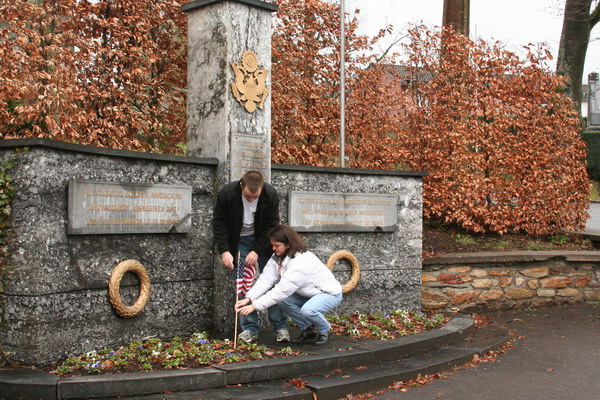
Several of the towns in the area still have reminders of the battle.
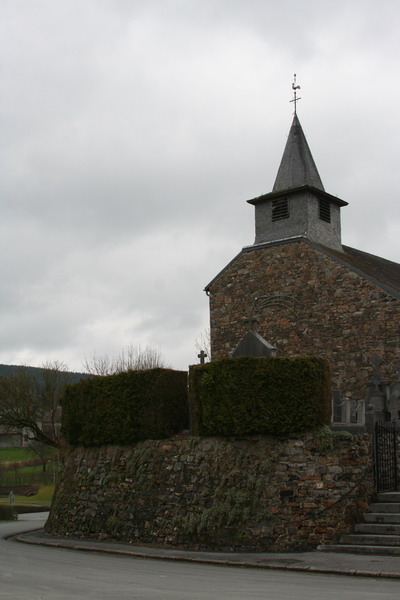
This 640 horse power, 50-ton, Tiger I Tank is another visual reminder of the power of the German military. It was a fearsome adversary.
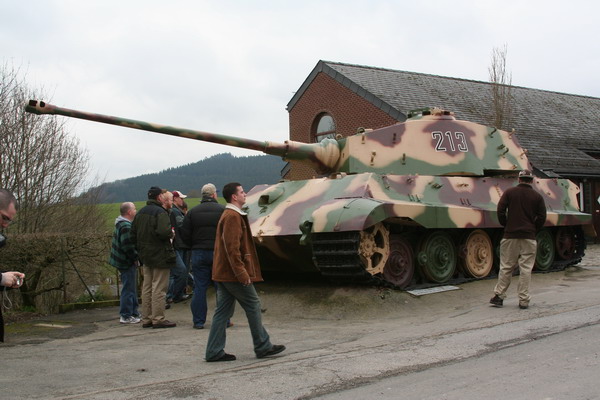
Of course, even in the midst of documenting this battle, flowers are a strong symbol of peace and regeneration.
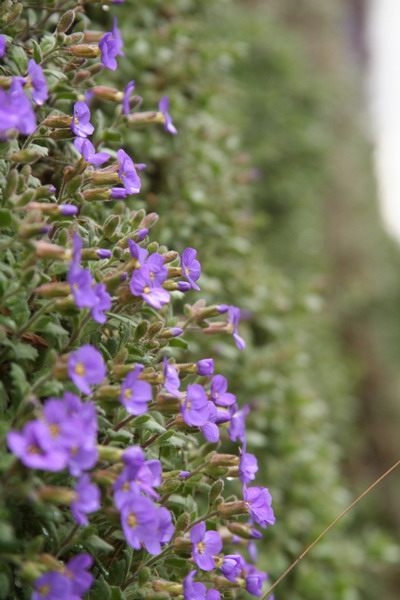
Our next stop was to witness the result of the ferocious battle, the Ardennes American Military Cemetery. This 90-acre memorial is the final resting place for 5,329 American service members, many of whom died in the Battle of the Bulge. You can see the American Eagle, a 17 foot high symbol of the American military. Beside it are three figures representing Justice, Liberty and Truth. The thirteen stars on the other side, represent the original colonies of the US.
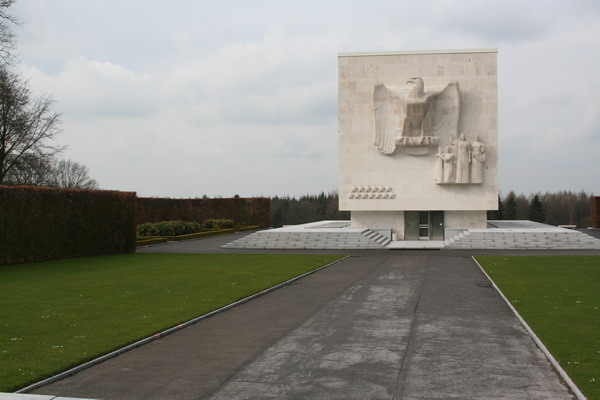
This sign shows that dogs are prohibited (even on a leash) and silence and respect are strictly enforced.
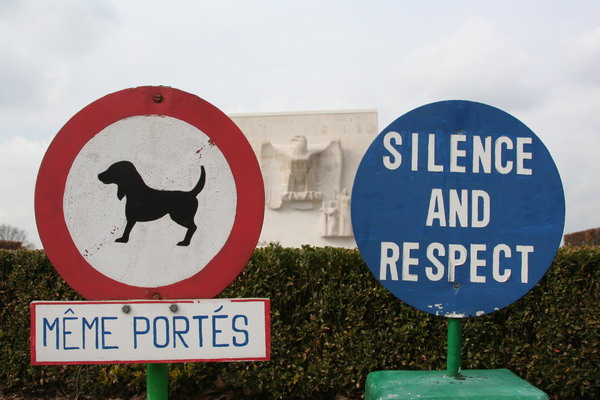
This relief map shows the bulge in the operation. Also, at the crossroads in the lower right corner is the town of Wittlich, near where we live.
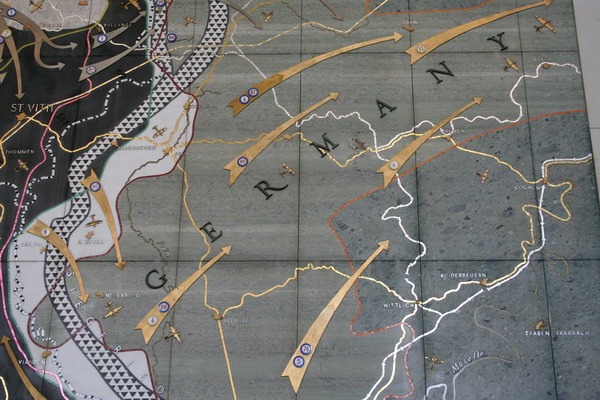
This legend depicts who was involved in the battle.
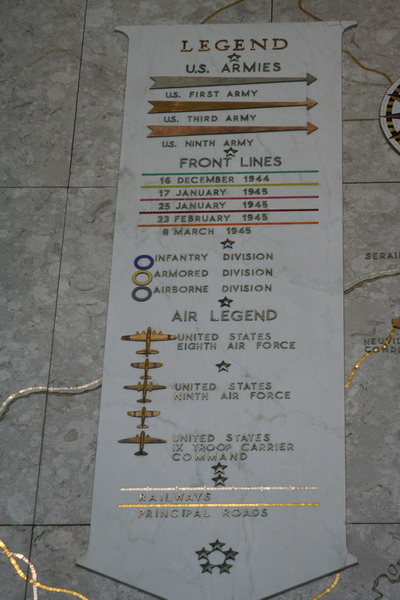
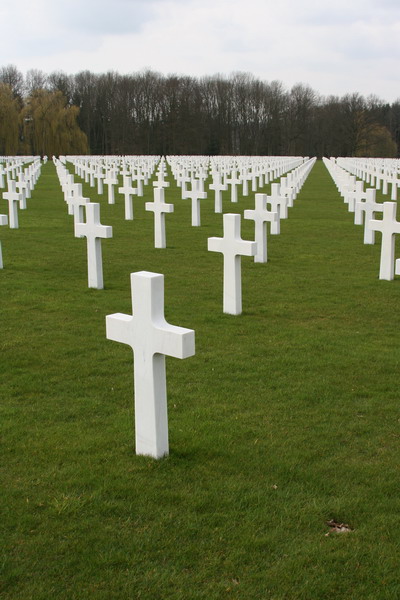
The several images below depict the grave sites. The overall layout is in the shape of a Greek Cross. Sixty percent of those buried here were Airmen. So, it made for a particularly poignant stop.
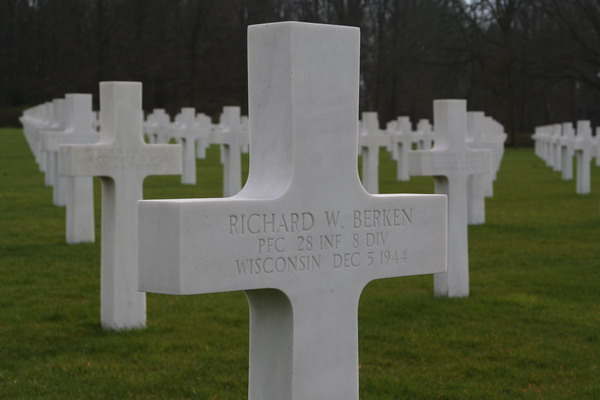
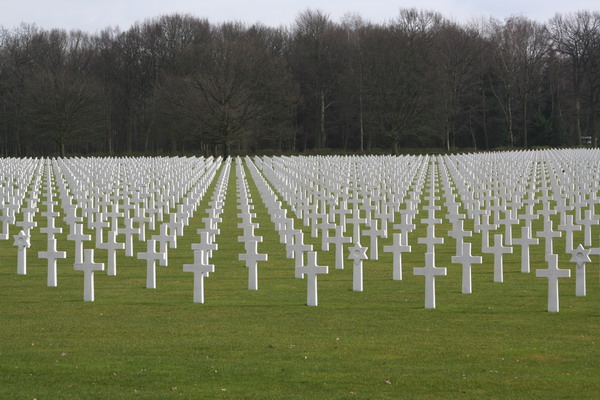
Here is another view of the Stars, Eagle, Justice, Liberty and Truth.
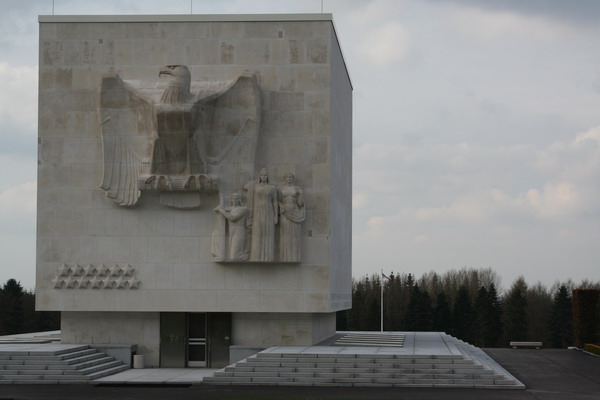
It was a very historic day. I am always humbled to take part in activities like this. A day to remember our past and not forget what it means to be an American service member.
So, until the next adventure … back in France.
–Jim
Iraq — day to day, part 2
While the US has been on this base for a relatively short period of time, the base has been around since the 1930’s.
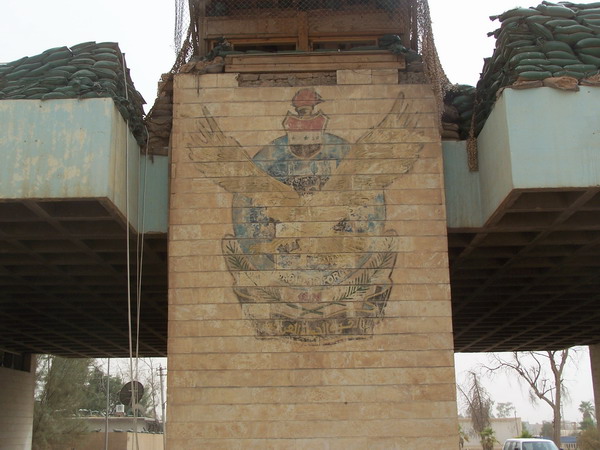
One of the areas we are responsible for is minor construction. So, we’ve been busy building things all over the base. This is one of our larger projects. We built several offices and a conference room for the Army. Nail guns are very handy for framing walls.
Although Clay (holding the nail gun) is an entomologist, he helped out with a lot of the construction. It just shows how multi-skilled the guys are.
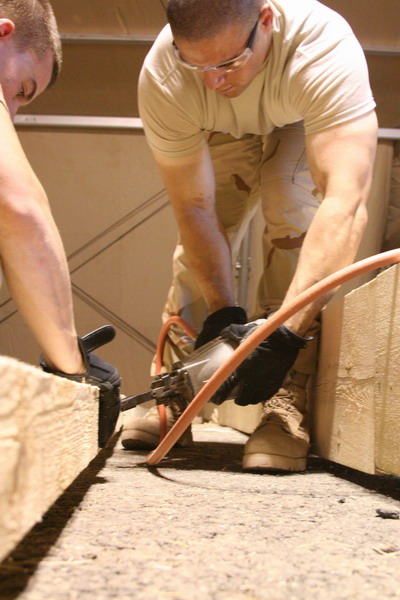
Chris was my project lead for a couple large projects (including this one). He did a great job. Actually, all my Airmen have been an outstanding team. Any success we’ve had is directly because of their skills and hard work.
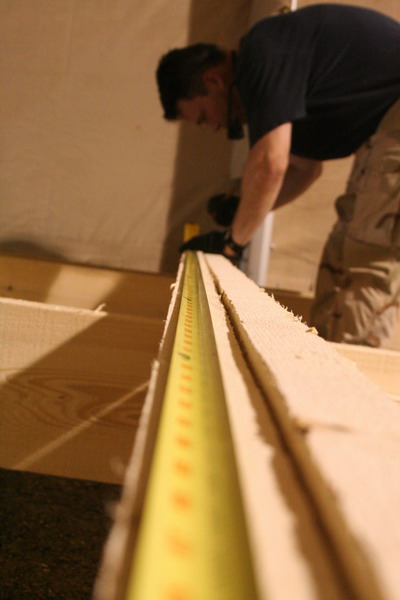
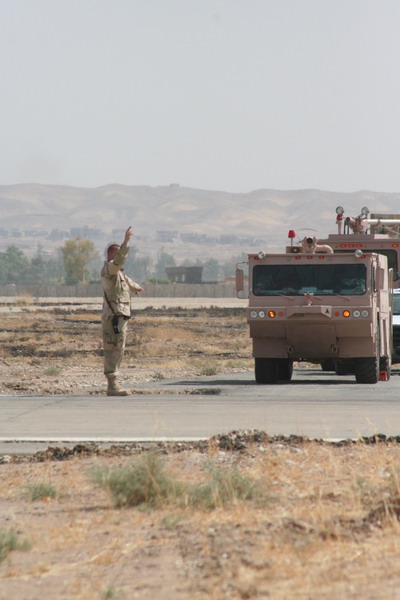
Although Rob is our first sergeant and responsible for the morale, welfare, and conduct of all enlisted members of the squadron, he is also a power pro expert and helped out the guys in the shop quite a bit.
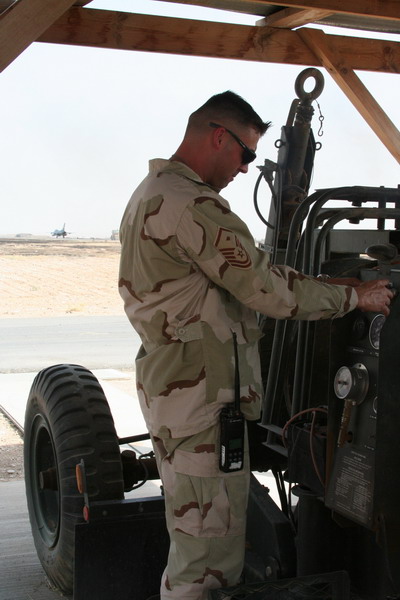
He even taught a medic, Yvonne, how to run some of the equipment.
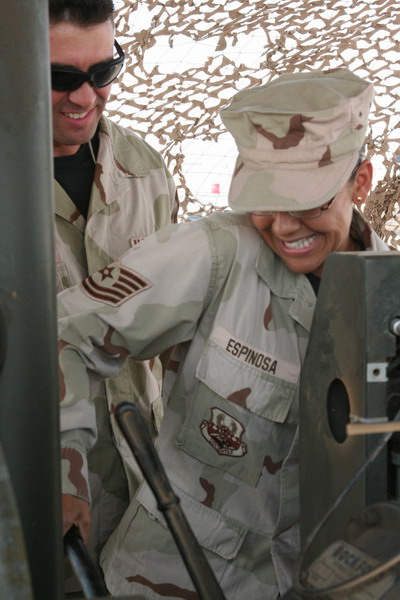
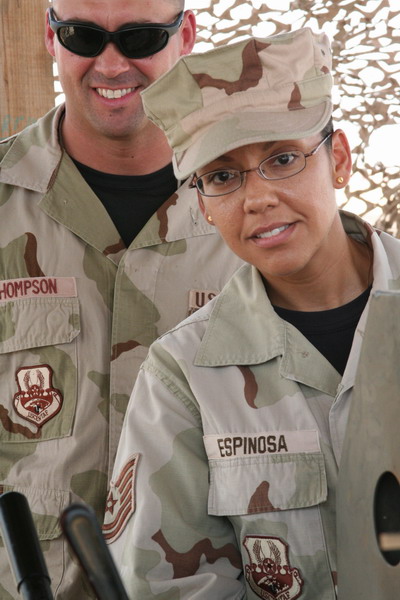
You can see the sort of dust storm the helicopters kick up.
My Structures Airmen are not only skilled with wood, they can also create metal works of art.
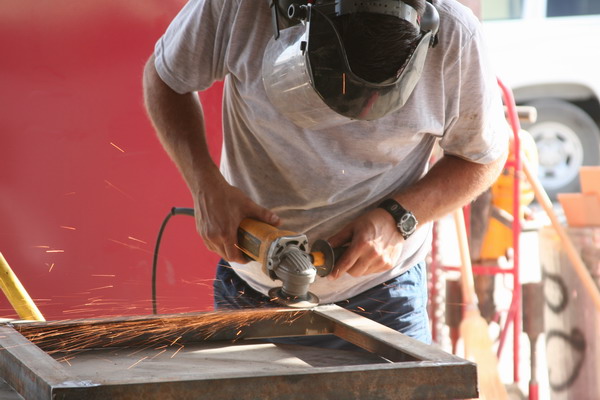
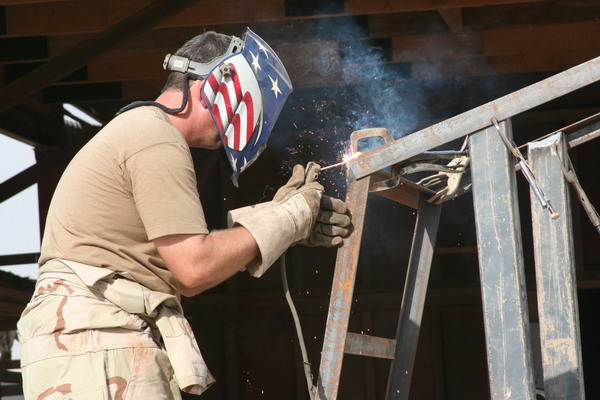
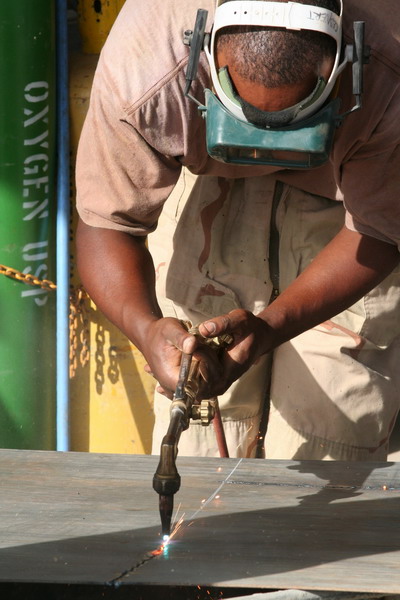
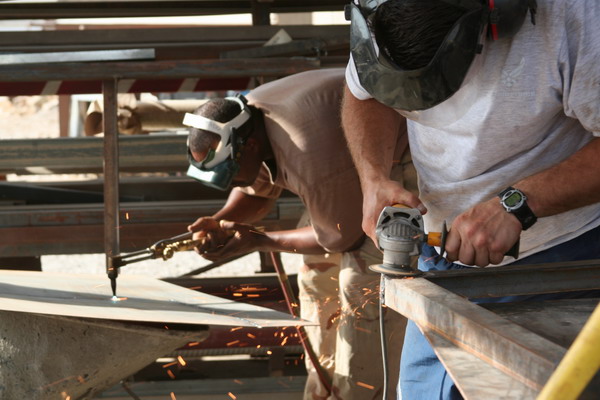
Plumbers have, without question, one of the dirtiest, under-appreciated, but most important jobs. The picture below is of a pump that failed on the sewage line. They worked through the night to fix it and ensured that sewage kept flowing where it was supposed to. People flush the craziest things down the toilet… I’ll just leave it at that.
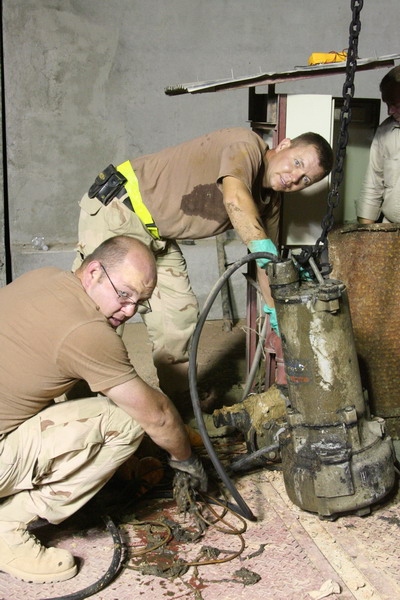
The utilities shop also fixes all manner of water leak, break or other utilities problem.
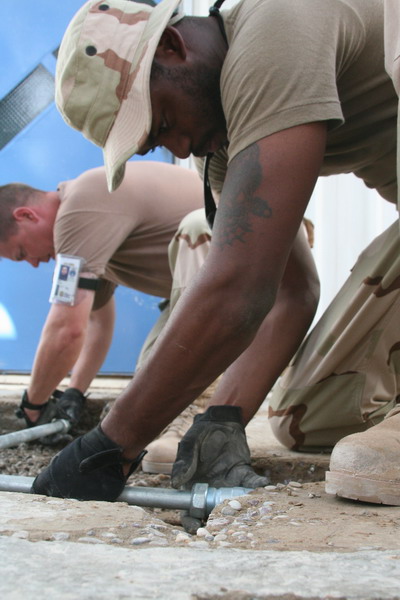
This is a picture of the infamous camel spider. It has gained much ill repute from a number of urban legends, including an email hoax that shows a photo of two huge spiders, each the size of a man’s calf, and is accompanied by an alarming note. The sender said his or her friend (or friend of a friend) knew a soldier stationed in Iraq who had said that these spiders could inject a sleeping soldier with anesthetic, then chew out a chunk of flesh. However, a 2004 National Geographic article http://news.nationalgeographic.com/news/2004/06/0629_040629_camelspider.html enlightens us about the truth of these fascinating creatures. However, here are a few more of the myths propagated by the hoax:
“Camel spiders are said to run as fast as 25 miles an hour (40 kilometers an hour), jump six feet (two meters) in the air, and lay their eggs inside a camel’s belly (hence the name camel spider).”
In fact, camel spiders (also known as wind scorpions) aren’t even spiders (although they are in the 8-legged arachnid family). They’re actually solpugids, or solifugids and don’t have any venom glands. The largest species are 6-8 inches long (the one below is about 4 inches). Also, they are fast, but often are only running to seek shade from the blistering desert sun. When I got close for the picture, this one wanted to run into my shadow.
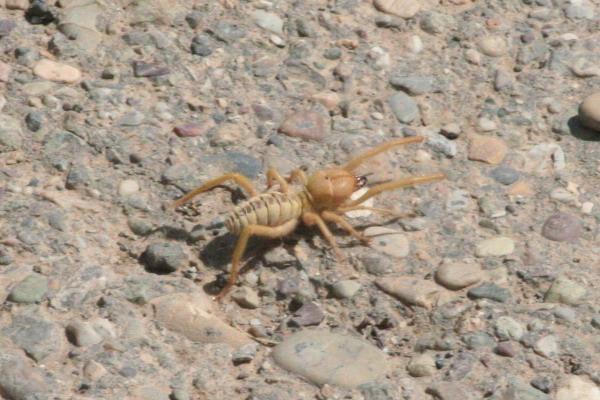
This fledgling barn owl was adorable and we relocated him to another part of the base where he could learn to fly away from people (he kept running into things as he flew around).
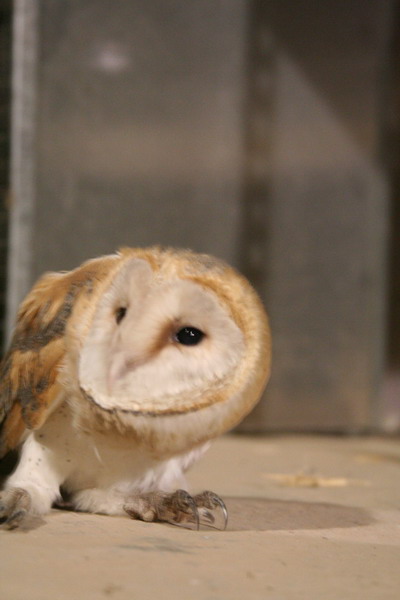
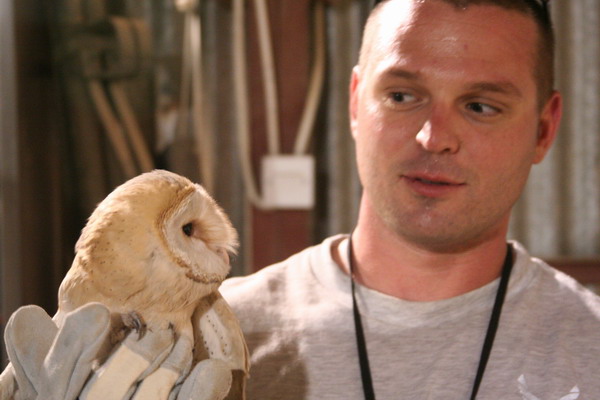
Well, that about sums up things that have been happening over the last 4 months. Of course, I’m always happy to explain further. Please feel free to leave a comment/question and I will email a response.
–Jim
Iraq — having fun
This post will be about some of the activities we’ve done to relax.
While going out to dinner, or playing a round of golf is outside the realm of possibility, there are plenty of things to do.
Quite honestly, the two most popular activities here are watching movies and playing video games. While I am not a fan of the later, I have watched a couple movies in my limited free time. Here are some images from events that have kept the base entertained.
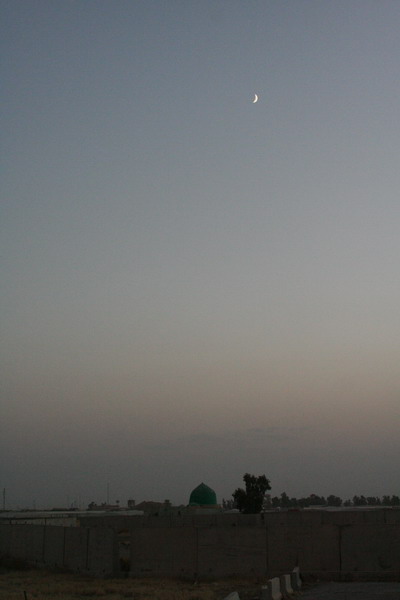
Perhaps you’ve heard of Amateur Night at the Apollo in New York. Well, we had a similar talent show here. A lot of courageous people got in front of a large audience and showed off their skills. The Apollo’s trademark is “Where stars are born and legends are made,” and although there were no big-time producers in the audience, there were plenty of stars in the making.
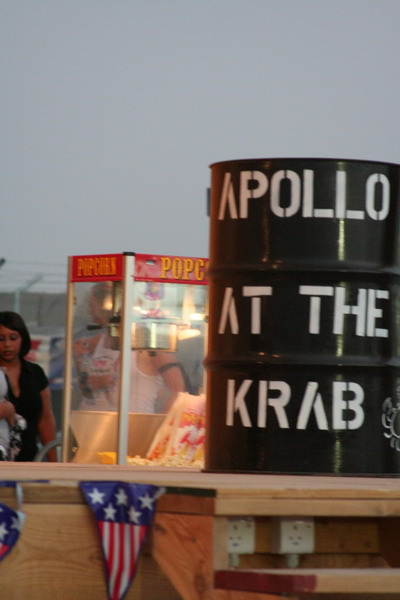
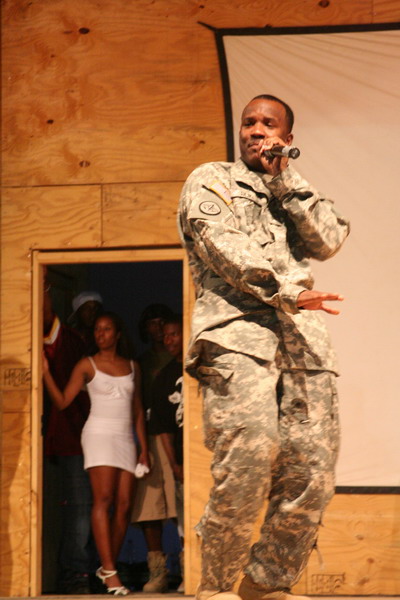
This trumpeter is an amazing musician.
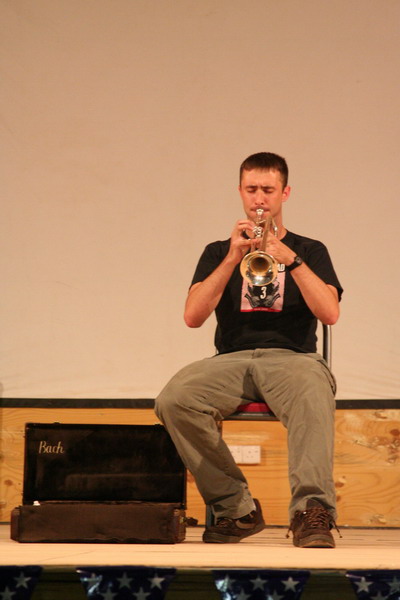
I know this guy looks a little funny here, but he was actually a very talented break dancer.
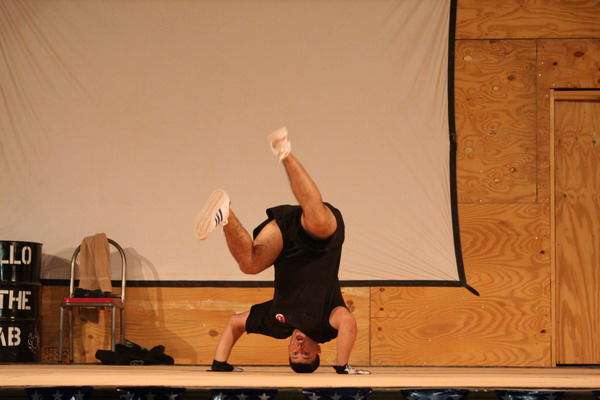
My guys also finished building this stage. As you can see, we didn’t wait until it was completed before using it as a venue for concerts.
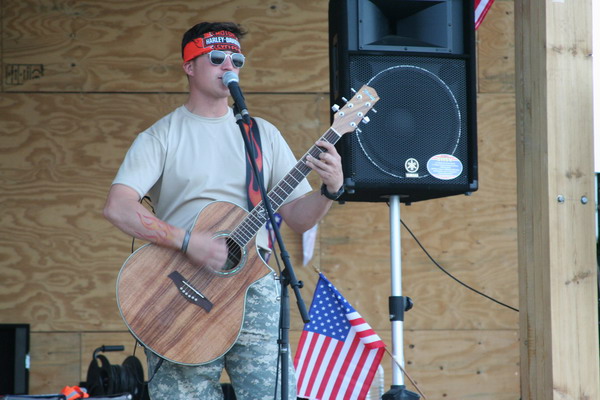
The fire department invited us out for a barrel competition. As you can see, it’s a two-person team that uses the fire hose to push a barrel to one side or the other.
It’s a deceptively simple concept: use a hose to push a barrel past the other team. However, the water really obscures your vision, and the water pressure makes the hose come alive.
When it was my turn to go, I managed to keep the barrel in the middle for about… 30 seconds. Oh well, it was fun nonetheless.
September 18th, 2007 will be the 60th anniversary of the US Air Force. To celebrate this occaision, our base decided to have a number of events. That has included a flag raising, a series of lectures on historic events in our service’s short history and a series of athletic competitions.
The pictures below are from the base photographer, who documented the competition.
The first event was a game of elementary-school-style kickball. The teams were broken up roughly by rank. So my teammates were company grade officers (lieutenants and captains). Surprisingly, we remembered how to play pretty well and actually won the event.
This is me sending the ball on a little ride.
The next event was the formidable dizzy bat.
You can see here that I had the job of counting revolutions as people spun around the bat. Also, I tried to help people from falling too hard on the rock hard ground.
Then, it was my turn. I really didn’t want to go (not a big fan of spinning around in circles), but my team pleaded that we didn’t have enough people to compete. So, I acquiesced.
As expected, it was a little tough to run in a straight line. In fact, I was barely able to stay on my feet! But, somehow managed to get through to the finish line.
Unfortunately, one of my teammates, Tyler wasn’t able to keep his footing. At least he was still smiling. 🙂 Unfortunately, we weren’t quite fast enough to win this event.
Our Army brethren also joined in on the fun.
The next event was a mental challenge. We competed in a lively game of trivial pursuit, where we tied for the win with a question about which country had a sword and shield program that taught young children how to fire AK-47s (answer: the Soviet Union).
However, following the mental strain, we decided to revert back to athletic competition with a sprint triathlon. I tried to be the organizer, race director and competitor. Let’s just say the event gave me new found appreciation for my friends on Guam who do that all the time. I had helped, but never ran one myself. I was glad to do it, but it certainly was a challenge. Oh, and this was at night, so I had already worked outside all day setting up the tents you saw in the last post. By the end, I was completely wiped out. But, it was still fun.
Vince Vaughn and Ben Stiller have done much to bring dodgeball back to the mainstream. However, the company grade officers proved we had much to learn about the sport, since we finished dead last in this event.
The last athletic competition was a 10K race. This one was different from all the others and started before sunrise. It was a perfect morning for a run.
Jake and I ran most of the race together. I’ve found it’s much more fun to talk and run with someone else, than in silence by yourself (since we can’t wear headphones outside).
After each event, my team joined me here for a BBQ and social gathering. It’s nice to be able to hang out with peers and just relax.
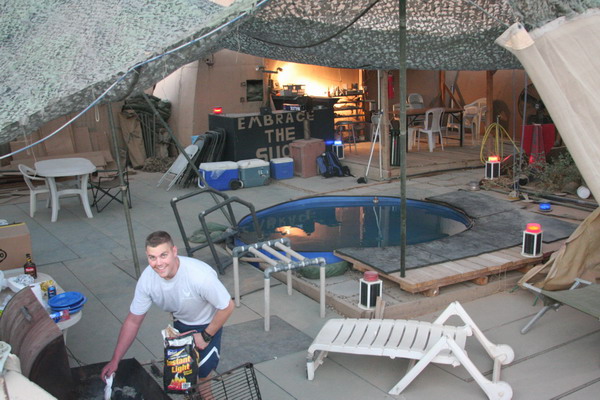
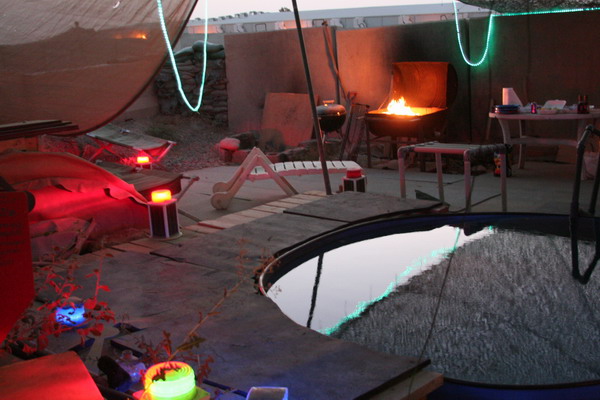
So, those are a few of the things I’ve done to relax and enjoy my time more here.
–Jim
Iraq — day to day, part 1
Well, I have now been in Iraq for 4 months. I’ve seen beauty and ugliness here. However, the experience has been very rewarding and overall a very positive one. In a few short weeks, I will be home in Germany.
Below are some images from my time here.
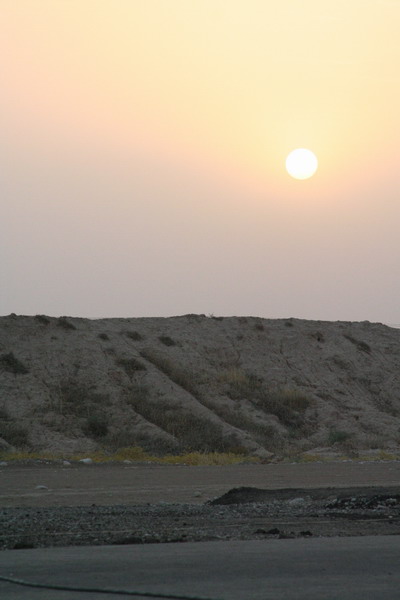
If you think this plane looks small, it is. This is a UAV the Army flies here.
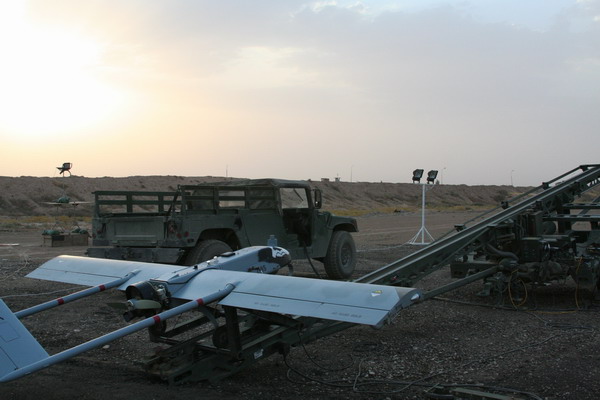
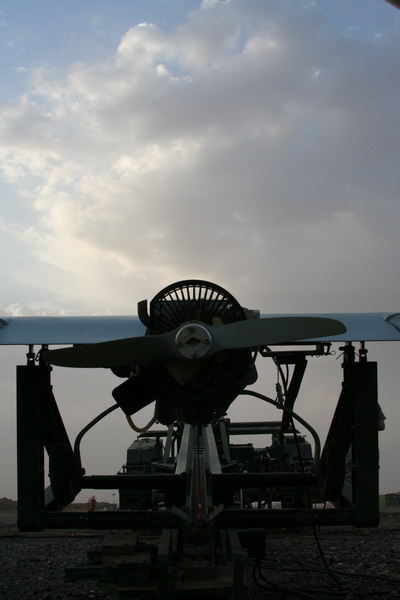
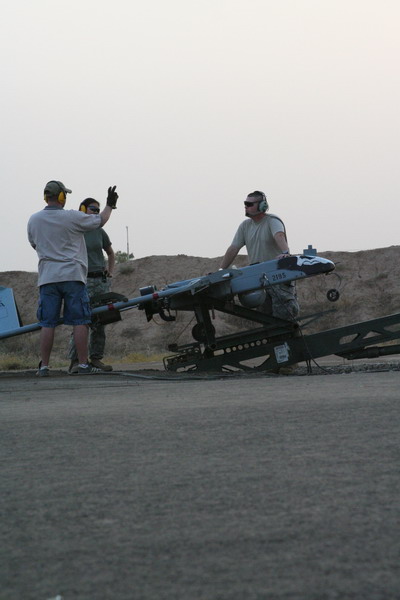
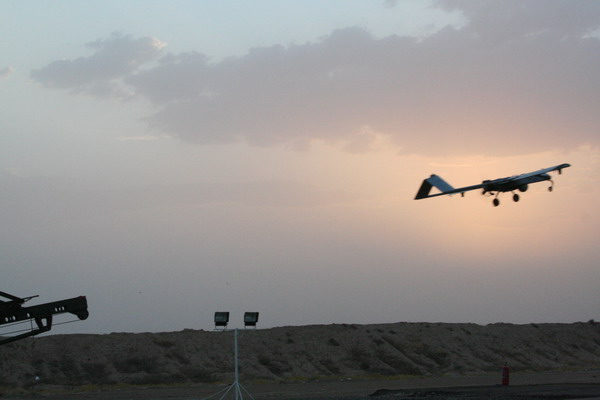
As you can imagine, our explosive experts capture a lot of weapons. These can be used against us, so to eliminate that threat, we confiscate and dispose of them. Below are some pictures of that disposal process.
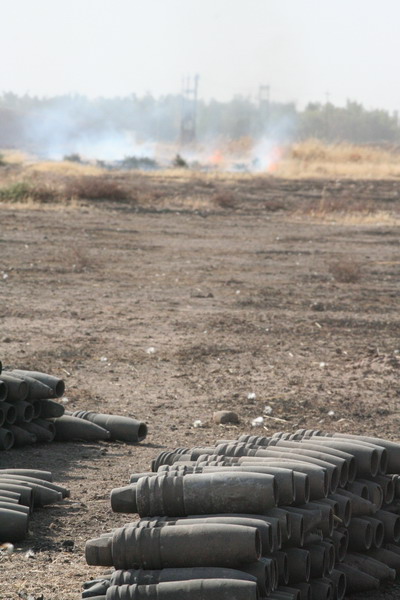
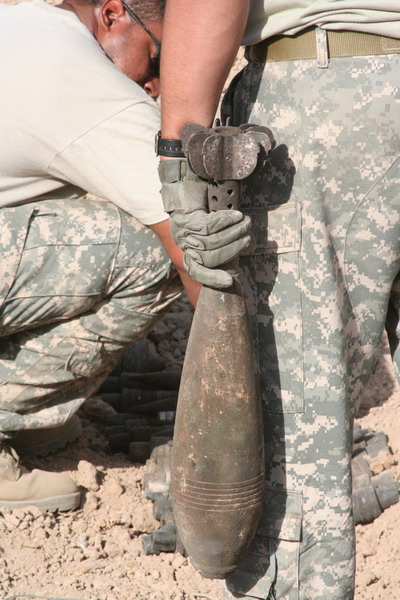
You can see the C-4 (in the green plastic) that is used to detonate the explosion. Also, below are unserviceable US hand grenades. In this case, some parts have corroded and it’s safer to blow them up, then ship them home. If you’ve been reading my blog for a while, you’ll remember that we did something similar with old bombs on Guam.
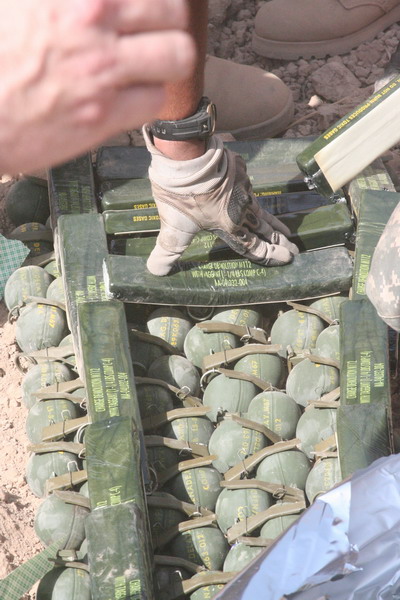
Here’s the pit, ready to blow.
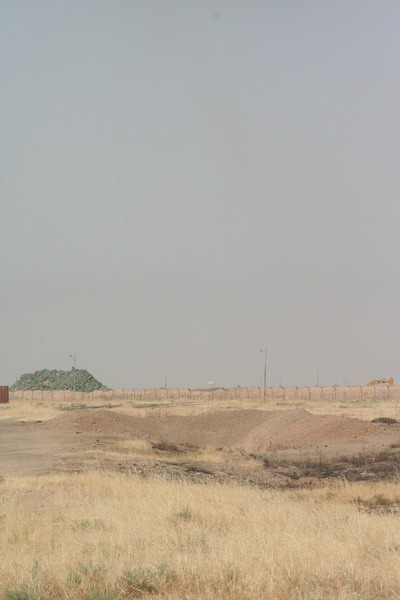
Fire in the hole!
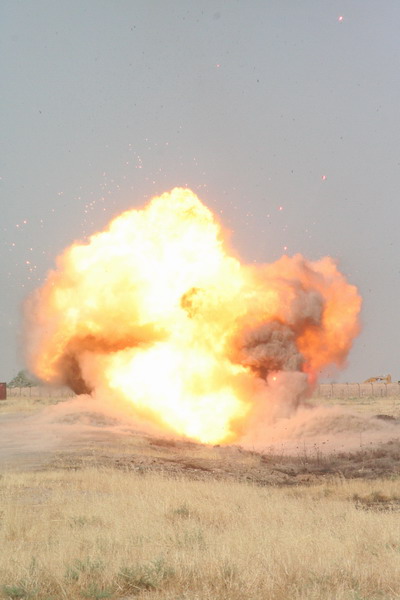
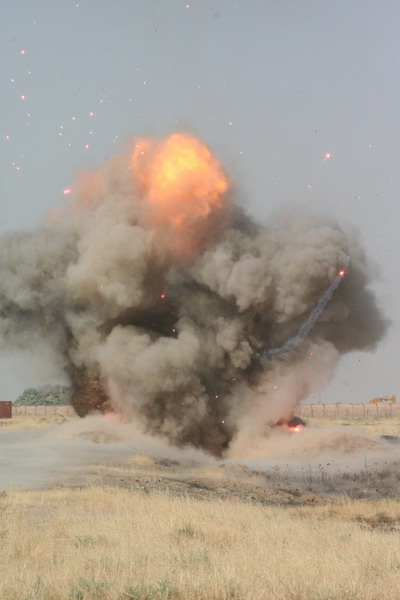
It seems that scorpions are attracted to me (or me to them). I have seen a whole bunch of them here… in my office, bedroom, on the road, and now, right next to an active explosive ordinance disposal site.
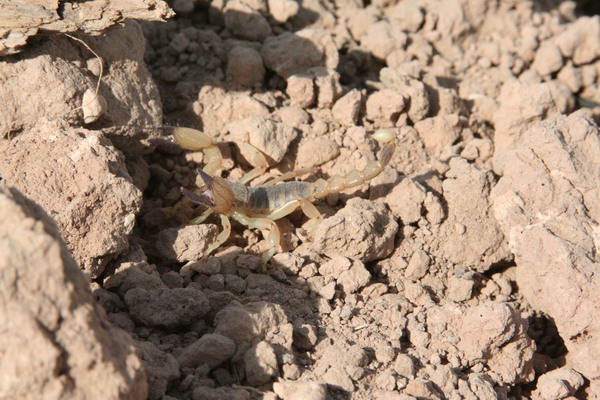
Disclaimer: I did not take the rest of the pictures on this post (they came from either the base photographer or the public affairs chief).
We have done a lot of concrete work here. The Airmen in the shop responsible for placing all that concrete are affectionately knows as Dirt Boys. Officially, however, they are heavy equipment operators. For larger projects like this one, they enlist the help of other volunteers to finish quickly. In the heat of the desert, concrete dries very fast.
Trivia: a common misconception is that concrete and cement are synonymous. That is only partially true, concrete is cement, but cement is not concrete. Cement is actually a component of concrete that when mixed with sand, water and gravel forms that familiar hard building material.
As you can see, the Dirt Boys took any help, including my unskilled labor.
There are very unique animals here. This majestic cat is known as a Jungle Cat or Felis chaus. Jungle cat is an interesting name, since it is found in Egypt, West Asia, India, Sri Lanka and Southeast Asia, but nowhere near a rain forest (I can attest that there is nothing remotely like a jungle in this area). It is only slightly larger than a domestic cat, but has a relatively short tail. So, it’s name notwithstanding, the entomologists (not to be confused with etymologists) catch these cats from time to time and relocate them to another place on the base. They are certainly not dangerous to humans, but ideally we try to limit their contact with us.
This next group of pictures is from a big event we had to raise large, living tents on base. As you can see, they are rather complicated to assemble. So, we used one or two craftsmen with a group of volunteers to erect the tents.
Rolling the rain fly to get it ready for installation.
Putting the wall sections on.
One, two, three… up!
Then, inside to check all the safety pins are inserted.
It was a long, hot day and a little Flavor Ice tasted good.
So, that concludes this first part. Hopefully, you have a little better idea what day to day life is like on the base.
–Jim
Iraqi Flora and Fauna — Small
I know it has been a while since I posted a new entry. My apologies for the delay. This is the first of what I hope is at least a two part post. I am trying to capture an image of all the fauna I see running around.
As I become more familiar with my location, I see more and more life teeming all around. Although I don’t want to get particularly close to some of it, it’s fascinating to watch.
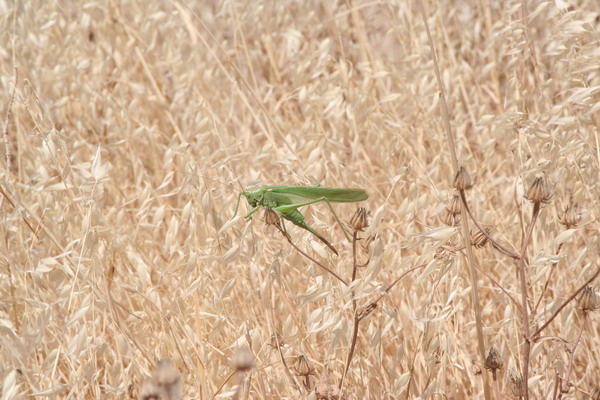
As you can see, this isn’t living fauna, per se, but it’s fitting for the base. 🙂 This work of art was created my one of the craftsmen here.
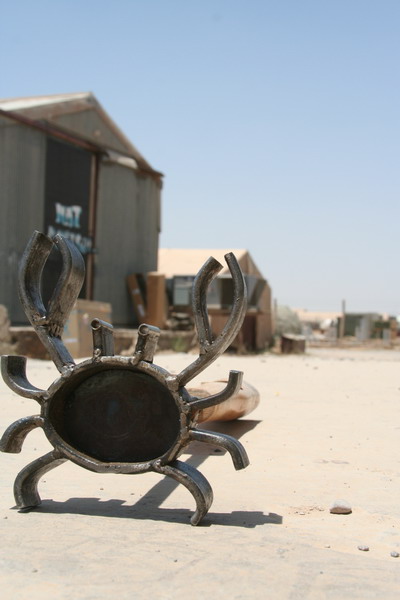
In the desert, one doesn’t normally expect to find a koi pond. However, here the brine water (the by-product of water purification) has to go somewhere. It creates a little lake and the operators have discovered koi enjoy the water.
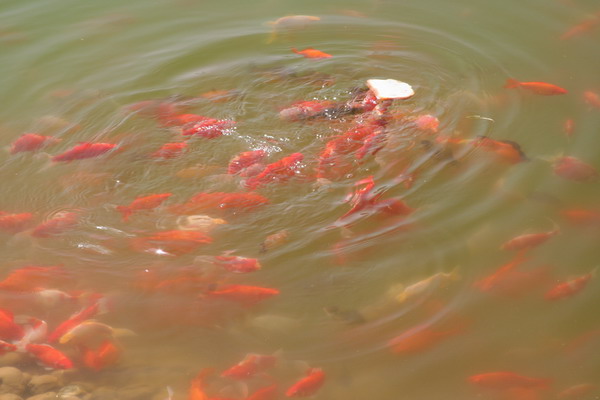
This predator is adept at digging beneath the sand. In fact, as a result it is named the Sand Boa. In the hot desert sun, the sand provides needed relief for this reptile. It often buries itself and only exposes its head, waiting for a small rodent to scurry by. Like all boas, it uses constriction to subdue its prey.
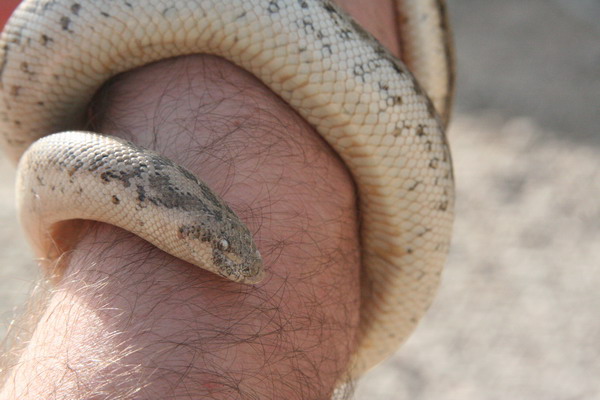
In fact, this cute, little guy could end up being dinner for the sand boa.
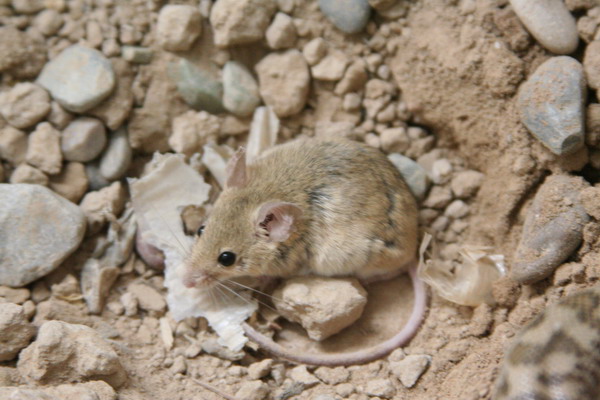
The Praying Mantis.
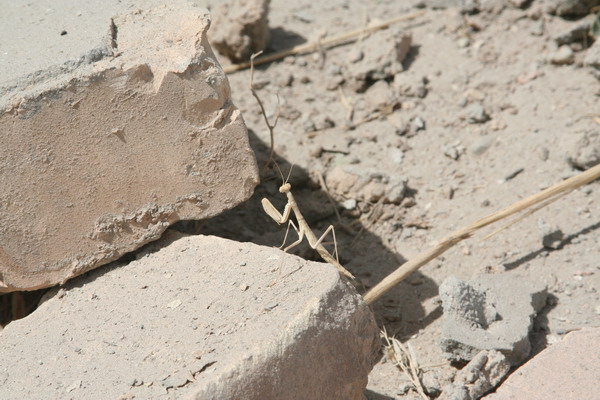
This is an example of fauna that I don’t want to get too close to. Unfortunately, he chose to get close to me this week. In my room here, I have 5 glue covered white boards on the floor. They are intended to catch rodents, but as you can see here, it also catches other little critters. This particular scorpion got stuck to the one that is right next to my bed… Fortunately, he chose to traverse the board, instead of my bed. If you’re interested in this particular species, its scientific name is Androctonus crassicauda. I originally thought he was only a “medium dangerous” species, but just got an email from a scorpion expert correcting me and said that this little guy is “bad boy #1” and is perhaps the most deadly scorpion in the region. Nice, huh?
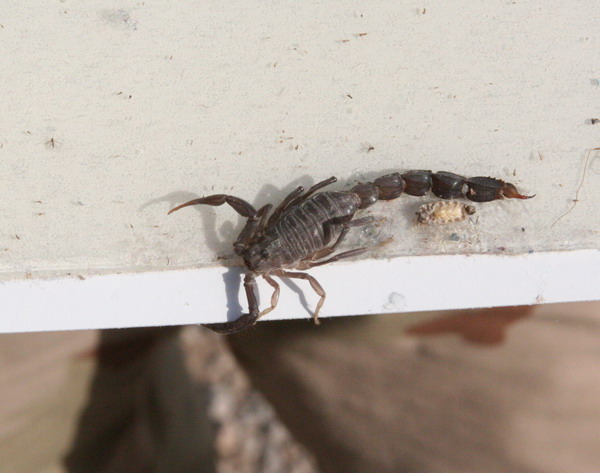
Here’s another image of him with his pincers open.
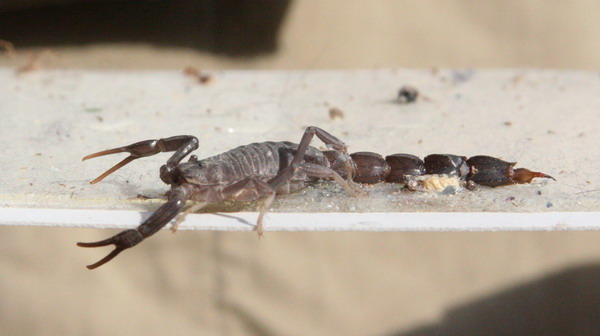
As an aside, I also discovered a small (relatively) harmless scorpion in my office as well. So, they are rather common here. For those of you who live in the desert, it’s no big deal, but this is my first time seeing a number of them in a short period of time. The scorpion below is, Mesobuthus eupeus. Supposedly, its sting is painful, but not as serious as the one above.
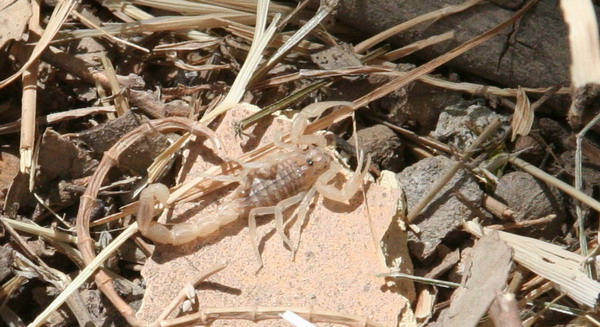
Then, to finish the fauna section, with a friendlier animal.
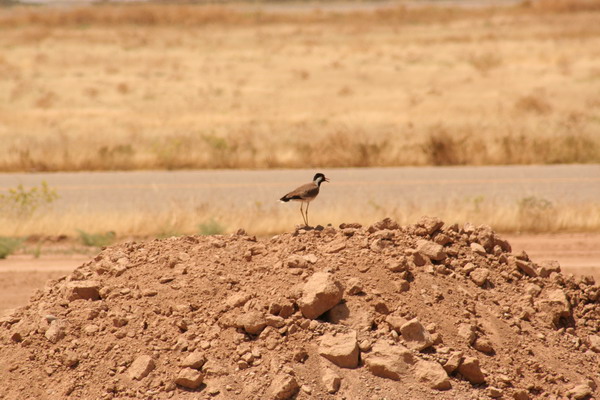
The last and only image of flora from the area is this flower. It bloomed for about 3 weeks, then disappeared.

Well, that sums up the small flora and fauna from my area here. Hopefully, I will be able to add another post with more plants and animals soon.
So, until the next post.
–Jim
Deployment begins…
This begins by deployment to Iraq. I have decided to continue updating the website as more of a traditional blog, instead of a travelogue.
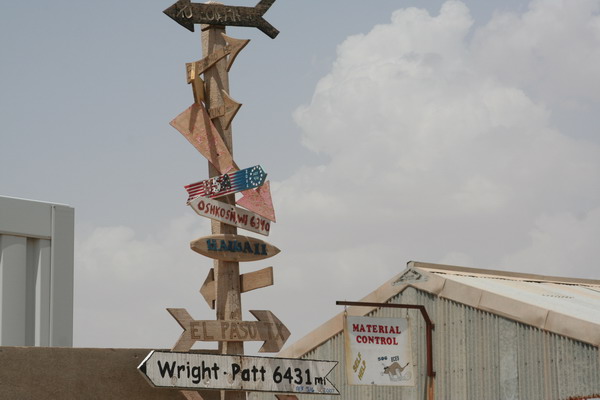
Hello again everyone. Well, I have arrived at my new home for the summer/fall. Even though I have deployed before, it’s certainly a bit of an adjustment to re-acclimate to the deployed environment.
Now, let me fill you in on some of the details that have taken me from Germany to Iraq.
The US military is second to none in its ability to transport personnel and equipment from one place to another. However, it was still a very long process to gather all the requisite gear, process the right documents, attend briefings to make sure Anna and I had all the information we needed, and finally to assemble that gear and start the journey to our final destination. All told the transportation alone took three and a half days, and Germany is only two time zones away. I point this out to imagine how far we, as a military, have come. A comparable trip only a half century ago would have taken much longer.
Let me explain some of the logistics involved. We were transported by bus to an air terminal. We waited there for about 8 hours, before going back home for the night (the plane had been delayed). It was nice to be able to go home again and spend another night with Anna. It actually made leaving a little more palatable for both of us. The next day, we repeated the process, except this time, the plane actually arrived. However there was more maintenance problems, so we were delayed again, but eventually left.
One of the little know facts about US Air Force transports is that we utilize something called the Civil Reserve Air Fleet. That is made up of civilian passenger and cargo aircraft to supplement military transports when the demand exceeds the military’s intrinsic capability. As of the end of last year, there were 39 carriers and 1,379 aircraft enrolled as part of the Civil Reserve Air Fleet. That translates to over $2.5 billion in contracts to civilian aviation. For example, the plane I flew over on was an ATA jet, filled with Airmen in their desert camouflage uniforms. Quite a site to see.
Anyway, after about a 4 hour flight, we arrived in Qatar (where I spent a significant amount of time on my last deployment). There, we found out our follow on flight to Iraq was a day later, so we got to enjoy the transient lodging accommodations. We (the five guys going with me) were in a large tent filled with about 50 bunk beds. Fortunately, we were the only ones there. Since we got in at about 3 o’clock in the morning, I decided to enjoy sleeping in a little bit. After wandering around during the day (and saying hi to a couple friends deployed there … hi, Brian and Katie) we gathered all our gear up and went back into the passenger terminal to wait. I think we ended up waiting for about 7 hours (more plane troubles), but eventually loaded up into a C-130. For those who have never had the pleasure of traveling by C-130, the mighty and venerable Hercules, I will explain a little of what it’s like: imagine cramming in to sit on cargo netting. Your neighbor on either side sitting so close that your shoulders are touching. To top it off, the people sitting across from you, are so near that you have to overlap your knees. So, there we sat with all of our gear on (Kevlar helmets and ballistic body armor) for our 4 hour flight. Unfortunately it seemed to be a trend, and we had to make an unplanned stop in Kuwait. Not to worry though, it was minor and we were back in the air in no time (well, actually, it was about 2 hours). Eventually, we arrived in Kirkuk, our final destination the next morning. The Airmen we were replacing met us at the airport and looked VERY happy to see us.
I spent the next several days learning as much as I could. Soon though, the Airmen we replaced headed out the door to return home. They had spent four months here and were ready to go. That brings up another interesting point. At this base, we have many joint operations with the Army and Iraqi Air Force (along with their American transitional team). So, it’s interesting to notice that the Air Force deploys its Airmen for somewhere bewteen 4 and 6 months. While the Army keeps their soldiers here for a year, but the ones here right now just found out they have been extended to 15 months. Even so, the morale of the base is remarkably high.
What do I do here? Well, without getting into too many specifics, I help manage the base’s infrastructure with maintenance, repair and minor construction. However, it’s the team of guys here with cross functional expertise to make that a reality. We in the Air Force, with the exception of our explosive ordinance disposal teams, stay exclusively on base to manage the base and our Air Force mission. It’s the Army soldiers who go out to patrol / protect the city of Kirkuk.
Kirkuk is a fascinating history and although I can only see it over the wall or through a fence, let me share a few of its highlights.
Kirkuk is in the Northern section of Iraq (about 240 kilometers north of Baghdad).
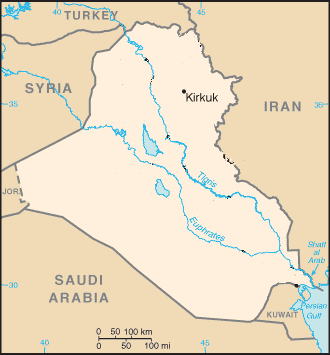
The approximately 750,000 residents of Kirkuk are very ethnically mixed among Kurds, Arabs, Assyrians, Turkmen and Armenians (plus both Shi’ite and Sunni Muslims live here). The big debate is the upcoming referendum in November or December 2007. It proposed, under the new Iraqi constitution, to have Kirkuk decide if it wants to join the Kurdistan Regional Government. That means that the 120,000 people forced out by Saddam after the 1991 Gulf War, who were replaced by tens of thousands of Arabs in an attempt to “Arabize” the city/region, could return home. That will effectively swing the balance of power toward the Kurdish ethnicity.
Another interesting, non-political fact about Kirkuk is that it is believed to hold the Tomb of David, a biblical prophet. But, there are at least two other sites that also claim to hold the tomb of Daniel. Probably the most famous story of Daniel is when he was cast into the lion’s den, but walked out, untouched.
So, hopefully, that gives you a little flavor of the area I am staying in and doing my part to help stabilize.
So, until the next post.
–Jim
My Favorite Pictures – Part 2
Ok, here is the second batch of my favorite pictures.
This next group of pictures is a SMALL sampling of pictures from my deployment to central and southwest Asia in 2003-04.
The first picture is the view from a road in Afghanistan, about 30 miles away from Kabul at Bagram Air Base. As you can see, the mountains were spectacular (20,000′ peaks near 360 degrees around). This particular location was a former Soviet base, which had been ravaged by over two decades of constant warfare. One of the reminders of that were the landmines. Afghanistan is the most heavily mined country in the world. Anytime you are on the other side of the wire (as seen in this picture), there is probably a mine very nearby.
I think that’s one of the reasons I like this picture so much. Stark natural beauty contrasted with the lethal realities of human warfare.
Ok, I’ll let the pictures speak for themselves.
In fact, this picture really captures my experience in Afghanistan. If you’ll permit me to indulge, I’ll explain what I mean.
I see:
– A man bearing an all too common mark of the ubiquitous
landmines
– The American influence with the desert camouflage
– The traditional Afghan hats
– The common scarf
– The cold in the air
– Bicycles as a main source of transportation
More images of Afghanistan:
My team also went into 5 other countries. Two of the most unique were the former Soviet states of Kyrgyzstan and Uzbekistan. Here’s one of a old Soviet era plane.
The other central Asian stop was in Pakistan. This is at a small base in central Pakistan. As you can see, we made friends with our Pakistani army escorts.
Our stops in southwest Asia included Qatar and Kuwait. Here’s the architectural icon of Kuwait City, the Kuwaiti Towers. It was designed in 1977 by a Swedish company. During the Iraq invasion of 1989, the Iraqis did their best to destroy it, but were unsuccessful and it survives today as a very nice landmark. The Tower on the right has a restaurant in the lower ball and the upper is an observation deck. The tower on the left is a water tower (nicest one I’ve seen!) and the small one in the center one lights up the other two at night.
In one of the bases there, we found remnants of the US bombing in Operation Desert Storm. These are hardened aircraft shelters built for the Kuwaitis by the French. They were purported to be indestructible. However, as you can see, they didn’t hold up too well to the US bunker buster bombs. As an interesting side note, the Kuwaitis went back to the French company and requested that they rebuild or repay since it was obviously NOT indestructible. The response was, well, we can’t warranty against the Americans. Sorry.
Here’s what they looked like over a decade later.
There were also plenty of camels just wandering around…
OK, I will stop this one here. The next entry will have Guam, Japan and Palau pictures.
–Jim
